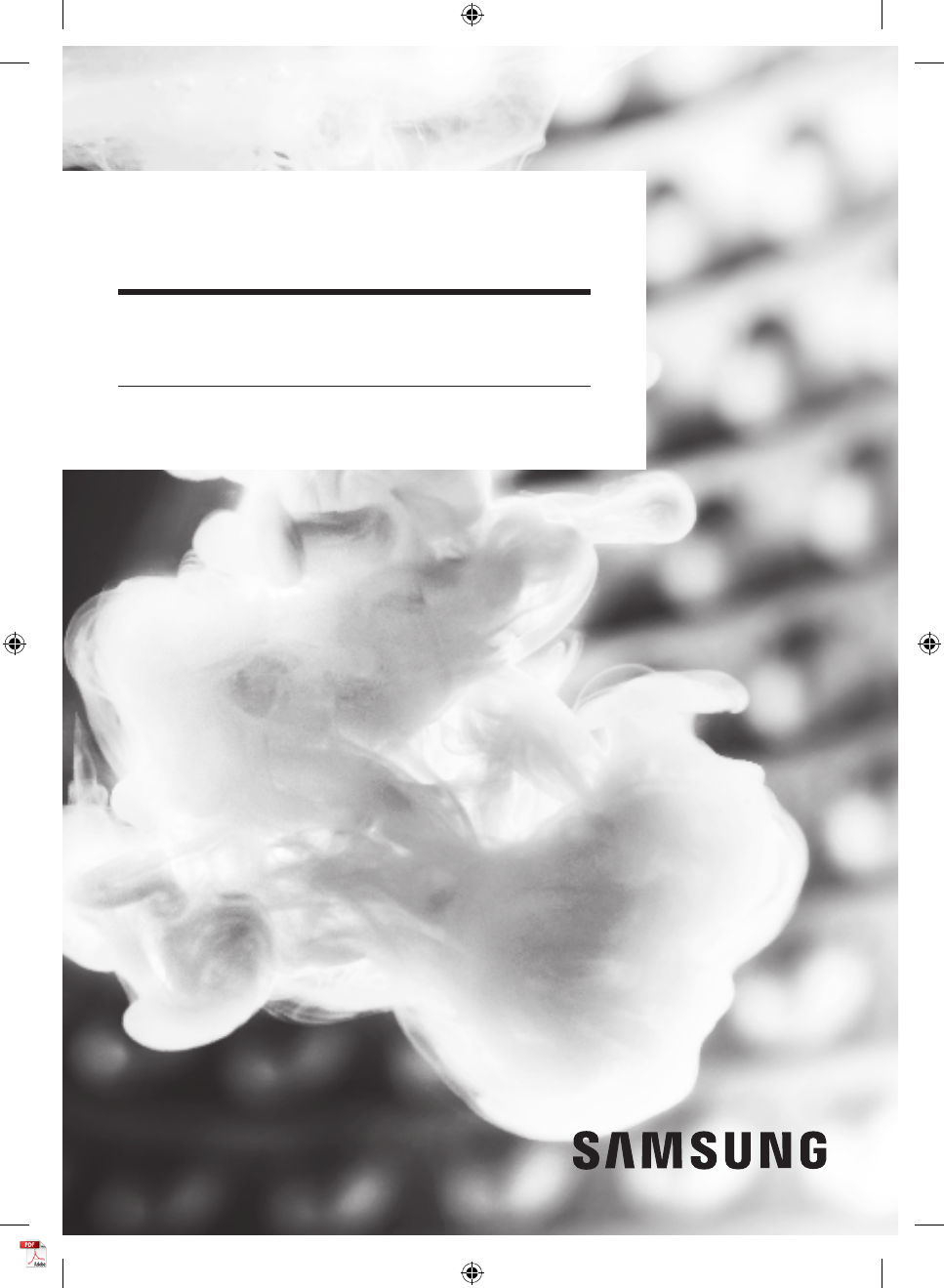
English
English2
Contents
Safety information
4
What you need to know about the safety instructions 4
Important safety symbols 4
Important safety precautions 5
Critical installation warnings 6
Installation cautions 8
Critical usage warnings 8
Usage cautions 9
Critical cleaning warnings 12
Instructions about the WEEE 13
Ecodesign 13
Installation
14
What’s included 14
Installation requirements 16
Step-by-step installation 18
Before you start
28
Initial settings 28
Laundry guidelines 28
Detergent recommendation 32
Detergent drawer guidelines 33
Operations
36
Control panel 36
Simple steps to start 37
Cycle overview 38
Settings 41
Maintenance
42
Drum clean 42
Smart Check
43
Emergency drain 44
Cleaning 45
Recovery from freezing 48
Care against an extended time of disuse 48
Untitled-1 2 2021-02-03 10:43:11

English
English 3
Troubleshooting 49
Checkpoints 49
Information codes 53
Specifications
55
Fabric care chart 55
Protecting the environment 57
Spare parts guarantee 57
Specification sheet 58
EPREL information 60
Indicative information (According to EU 2019/2023) 60
Untitled-1 3 2021-02-03 10:43:11

English
English4
Safety information
Congratulations on your new Samsung washing machine. This manual contains important information
on the installation, use and care of your appliance. Please take some time to read this manual to take full
advantage of your washing machine’s many benefits and features.
What you need to know about the safety instructions
Please read this manual thoroughly to ensure that you know how to safely and efficiently operate the
extensive features and functions of your new appliance. Please store the manual in a safe location close
to the appliance for future reference. Use this appliance only for its intended purpose as described in this
instruction manual.
Warnings and Important Safety Instructions in this manual do not cover all possible conditions and
situations that may occur. It is your responsibility to use common sense, caution and care when installing,
maintaining and operating your washing machine.
Because the following operating instructions cover various models, the characteristics of your washing
machine may differ slightly from those described in this manual and not all warning signs may be
applicable. If you have any questions or concerns, contact your nearest service centre or find help and
information online at www.samsung.com.
Important safety symbols
What the icons and signs in this user manual mean:
WARNING
Hazards or unsafe practices that may result in severe personal injury, death and/or property damage.
CAUTION
Hazards or unsafe practices that may result in personal injury and/or property damage.
NOTE
Indicates that a risk of personal injury or material damage exists.
These warning signs are here to prevent injury to yourself and others.
Please follow them explicitly.
After reading this manual, store it in a safe place for future reference.
Read all instructions before using the appliance.
As with any equipment that uses electricity and moving parts, potential hazards exist. To safely operate
this appliance, familiarize yourself with its operation and exercise care when using it.
Untitled-1 4 2021-02-03 10:43:11

English
English 5
Important safety precautions
WARNING
To reduce the risk of fire, electric shock, or injury to persons when using
your appliance, follow basic precautions, including the following:
1. This appliance is not to be used by persons (including children) with
reduced physical, sensory or mental capabilities, or lack of experience
and knowledge, unless they have been given supervision or
instruction concerning use of the appliance by a person responsible
for their safety.
2. For use in Europe: This appliance can be used by children aged from
8 years and above and persons with reduced physical, sensory or
mental capabilities or lack of experience and knowledge if they have
been given supervision or instruction concerning use of the appliance
in a safe way and understand the hazards involved. Children shall not
play with the appliance. Cleaning and user maintenance shall not be
made by children without supervision.
3. Children should be supervised to ensure that they do not play with
the appliance.
4. If the supply cord is damaged, it must be replaced by the
manufacturer, its service agent or similarly qualified persons in order
to avoid a hazard.
5. The new hose-sets supplied with the appliance are to be used and old
hose-sets should not be reused.
Untitled-1 5 2021-02-03 10:43:11

English
Safety information
English6
6. For appliances with ventilation openings in the base, a carpet must
not obstruct the openings.
7. For use in Europe: Children of less than 3 years should be kept away
unless continuously supervised.
8. CAUTION: In order to avoid a hazard due to inadvertent resetting of
the thermal cut-out, this appliance must not be supplied through an
external switching device, such as a timer, or connected to a circuit
that is regularly switched on and off by the utility.
9. This appliance is intended to be used in household only and it is not
intended to be used such as:
– staff kitchen areas in shops, offices and other working
environments;
– farm houses;
– by clients in hotels, motels and other residential type
environments;
– bed and breakfast type environments;
– areas for communal use in blocks of flats or in launderettes.
Critical installation warnings
WARNING
The installation of this appliance must be performed by a qualified technician or service company.
• Failure to do so may result in electric shock, fire, an explosion, problems with the appliance, or injury.
The appliance is heavy, therefore take care when lifting it.
Plug the power cord firmly into a wall socket that meets local electrical specifications. Use the socket for
this appliance only, and do not use an extension cord.
• Sharing a wall socket with other appliances using a power strip or extending the power cord may result
in electric shock or fire.
• Ensure that the power voltage, frequency, and current are the same as those of the product
specifications. Failure to do so may result in electric shock or fire.
Untitled-1 6 2021-02-03 10:43:11

English
English 7
Remove all foreign substances such as dust or water from the power plug terminals and contact points
using a dry cloth on a regular basis.
• Unplug the power plug and clean it with a dry cloth.
• Failure to do so may result in electric shock or fire.
Plug the power plug into the wall socket so that the cord is running towards the floor.
• If you plug the power plug into the socket in the opposite direction, the electric wires within the cable
may be damaged and this may result in electric shock or fire.
Keep all packaging materials out of the reach of children as these may be dangerous.
• If a child places a bag over its head, it may suffocate.
When the appliance, power plug or power cord is damaged, contact your nearest service centre.
This appliance must be properly grounded.
Do not ground the appliance to a gas pipe, plastic water pipe, or telephone line.
• This may result in electric shock, fire, an explosion, or problems with the appliance.
• Never plug the power cord into a socket that is not grounded correctly and make sure that it is in
accordance with local and national regulations.
Do not install this appliance near a heater or any inflammable material.
Do not install this appliance in a humid, oily or dusty location, or in a location exposed to direct sunlight or
water (rain drops).
Do not install this appliance in a location exposed to low temperatures.
• Frost may cause the tubes to burst.
Do not install this appliance in a location where gas may leak.
• This may result in electric shock or fire.
Do not use an electric transformer.
• This may result in electric shock or fire.
Do not use a damaged power plug, damaged power cord, or loose wall socket.
• This may result in electric shock or fire.
Do not pull or excessively bend the power cord.
Do not twist or tie the power cord.
Do not hook the power cord over a metal object, place a heavy object on the power cord, insert the power
cord between objects, or push the power cord into the space behind the appliance.
• This may result in electric shock or fire.
Do not pull the power cord when unplugging the power plug.
• Unplug the power plug by holding the plug.
• Failure to do so may result in electric shock or fire.
This appliance should be positioned so that the power plug, the water supply taps, and the drain pipes are
accessible.
Untitled-1 7 2021-02-03 10:43:12

English
Safety information
English8
Following the repair by a non-authorized service provider, self-repair or non-professional repair of the
product, Samsung is not liable for any damage to the product, any injury or any other product safety issue
caused by any attempt to repair the product which does not carefully follow these repair and maintenance
instructions. Any damage to the product caused by an attempt to repair the product by any person other
than a Samsung certified service provider will not be covered by the warranty.
Installation cautions
CAUTION
This appliance should be positioned in such a way that the power plug is easily accessible.
• Failure to do so may result in electric shock or fire due to electric leakage.
Install your appliance on a solid, level floor that can support its weight.
• Failure to do so may result in abnormal vibrations, movement, noise, or problems with the appliance.
Critical usage warnings
WARNING
If the appliance is flooded, turn off the water & power supplies immediately and contact your nearest
service centre.
• Do not touch the power plug with wet hands.
• Failure to do so may result in electric shock.
If the appliance generates a strange noise, a burning smell, or smoke, unplug the power cord immediately
and contact your nearest service centre.
• Failure to do so may result in electric shock or fire.
In the event of a gas leak (such as propane gas, LP gas, etc.), ventilate immediately without touching the
power plug. Do not touch the appliance or power cord.
• Do not use a ventilating fan.
• A spark may result in an explosion or fire.
Remove the washing machine door lever before disposing the appliance.
• If trapped inside the appliance, children may suffocate to death.
Make sure to remove the packaging (sponge, styrofoam) attached to the bottom of the washing machine
before using it.
Do not wash items contaminated with gasoline, kerosene, benzene, paint thinner, alcohol or other
inflammable or explosive substances.
• This may result in electric shock, fire, or an explosion.
Untitled-1 8 2021-02-03 10:43:12

English
English 9
Do not open the washing machine door by force while it is operating (high-temperature washing/drying/
spinning).
• Water flowing out of the washing machine may result in burns or cause the floor to be slippery. This may
result in injury.
• Opening the door by force may result in damage to the appliance or injury.
Do not touch the power plug with wet hands.
• This may result in electric shock.
Do not turn the appliance off by unplugging the power cord while an operation is in progress.
• Plugging the power cord into the wall socket again may cause a spark and result in electric shock or fire.
Do not let children climb in or onto the appliance.
• This may result in electric shock, burns or injury.
Do not insert your hand or a metal object under the washing machine while it is operating.
• This may result in injury.
Do not unplug the appliance by pulling the power cord. Always grip the plug firmly and pull it straight out
of the outlet.
• Damage to the power cord may cause a short-circuit, fire and/or electric shock.
Do not attempt to repair, disassemble, or modify the appliance yourself.
• Do not use a fuse (such as copper, steel wire, etc.) other than a standard fuse.
• When the appliance needs to be repaired or reinstalled, contact your nearest service centre.
• Failure to do so may result in electric shock, fire, problems with the appliance, or injury.
If the water supply hose comes loose from the water tap and floods the appliance, unplug the power cord.
• Failure to do so may result in electric shock or fire.
Unplug the power cord when the appliance is not being used for long periods of time or during a thunder or
lightning storm.
• Failure to do so may result in electric shock or fire.
If any foreign substance enters into the appliance, unplug the power cord and contact your nearest
Samsung Customer Service.
• This may result in electric shock or fire.
Do not let children (or pets) play in or on your washing machine. The washing machine door does not open
easily from the inside and children may be seriously injured if trapped inside.
Usage cautions
CAUTION
When the washing machine is contaminated by a foreign substance such as detergent, dirt, food waste,
etc., unplug the power cord and clean the washing machine using a damp, soft cloth.
• Failure to do so may result in discolouration, deformation, damage, or rust.
Untitled-1 9 2021-02-03 10:43:12

English
Safety information
English10
The front glass may be broken by a strong impact. Take care when using the washing machine.
• If the glass is broken, it may result in injury.
Open the water tap slowly after a long period of non-use, water supply failure, or when reconnecting the
water supply hose.
• The air pressure in the water supply hose or the water pipe may damage a part of the appliance or result
in a water leak.
If a draining error occurs during an operation, check if there is a draining problem.
• If the washing machine is used when it is flooded because of a draining problem, it may result in electric
shock or fire.
Insert the laundry into the washing machine completely so that the laundry does not get caught in the
door.
• If laundry gets caught in the door, it may result in damage to the laundry or the washing machine, or
result in a water leak.
Turn the water supply off when the washing machine is not being used.
• Ensure that the screws on the water supply hose connector are properly tightened.
Ensure that the rubber seal and front door glass are not contaminated by a foreign substance (e.g. waste,
thread, hair, etc.).
• If a foreign substance is caught in the door or the door is not completely closed, it may cause a water
leak.
Open the water tap and check if the water supply hose connector is firmly tightened and that there is no
water leak before using the appliance.
• If the screws on the water supply hose connector are loose, it may result in a water leak.
The appliance you have purchased is designed for domestic use only.
Using the appliance for business purposes qualifies as an appliance misuse. In this case, the appliance will
not be covered by the standard warranty provided by Samsung and no responsibility can be attributed to
Samsung for malfunctions or damages resulting from such misuse.
Do not stand on the appliance or place objects (such as laundry, lighted candles, lighted cigarettes, dishes,
chemicals, metal objects, etc.) on the appliance.
• This may result in electric shock, fire, problems with the appliance, or injury.
Do not spray volatile material such as insecticide onto the surface of the appliance.
• As well as being harmful to humans, this may result in electric shock, fire or problems with the
appliance.
Do not place objects that generate electromagnetic fields near the washing machine.
• This may result in injury due to a malfunction.
Water drained during a high-temperature wash or drying cycle is hot. Do not touch the water.
• This may result in burns or injury.
Untitled-1 10 2021-02-03 10:43:12

English
English 11
Draining time may vary depending on the water temperature. If the water temperature is too high, the
draining process starts after the water cools down.
Do not wash, spin, or dry water-proof seats, mats, or clothing (*) unless your appliance has a special cycle
for washing these items.
(*): Woollen bedding, rain covers, fishing vests, ski pants, sleeping bags, diaper covers, sweat suits, and
bicycle, motor cycle and car covers, etc.
• Do not wash thick or hard mats even if the washing machine mark is on the care label. This may result in
injury or damage to the washing machine, walls, floor, or clothing due to abnormal vibrations.
• Do not wash throw rugs or doormats with rubber backing. The rubber backing may come off and stick to
inside the drum, and this may result in malfunction such as a drainage error.
Do not operate the washing machine when the detergent drawer is removed.
• This may result in electric shock or injury due to a water leak.
Do not touch the insides of the drum during or just after drying as it is hot.
• This may result in burns.
The door glass becomes hot during washing and drying. Therefore, do not touch the door glass.
Also, do not allow children to play around the washing machine or touch the door glass.
• This may result in burns.
Do not insert your hand into the detergent drawer.
• This may result in injury as your hand may be caught by the detergent input device.
Remove the liquid detergent guide (applicable models only) when using powdered detergent.
• If not, water may leak through the front of the detergent drawer.
Do not place any objects (such as shoes, food waste, animals) other than laundry into the washing machine.
• This may result in damage to the washing machine, or injury and death in the case of pets due to the
abnormal vibrations.
Do not press the buttons using sharp objects such as pins, knifes, fingernails, etc.
• This may result in electric shock or injury.
Do not wash laundry contaminated by oils, creams or lotions usually found in skincare shops or massage
clinics.
• This may cause the rubber seal to become deformed and result in a water leak.
Do not leave metal objects such as safety pins, hair pins or bleach in the drum for long periods of time.
• This may cause the drum to rust.
• If rust starts appearing on the surface of the drum, apply a (neutral) cleansing agent to the surface and
use a sponge to clean it. Never use a metal brush.
Do not use dry cleaning detergent directly and do not wash, rinse, or spin laundry contaminated by dry
cleaning detergent.
• This may result in spontaneous combustion or ignition due to the heat from the oxidation of the oil.
Untitled-1 11 2021-02-03 10:43:12

English
Safety information
English12
Do not use water from water cooling/heating devices.
• This may result in problems with the washing machine.
Do not use natural hand-washing soap for the washing machine.
• If it hardens and accumulates inside the washing machine, it may result in problems with the appliance,
discolouration, rust, or bad odours.
Place socks and brassieres in a washing net and wash them with the other laundry.
Do not wash large laundry items such as bedding in the washing net.
• Failure to do so may result in injury due to abnormal vibrations.
Do not use hardened detergent.
• If it accumulates inside the washing machine, it may result in a water leak.
Make sure that the pockets of all the clothing items to be washed are empty.
• Hard, sharp objects such as coins, safety pins, nails, screws, or stones can cause extensive damage to
the appliance.
Do not wash clothing with large buckles, buttons or other heavy metal objects.
Sort the laundry by colour on the basis of its colorfastness and select the recommended cycle, water
temperature and additional functions.
• This may result in discolouration or fabric damage.
Take care that children’s fingers are not caught in the door when you close it.
• Failure to do so may result in injury.
To prevent odours and mould, leave the door open after a wash cycle to allow the drum to dry.
To prevent limescale build up, leave the detergent drawer open after a wash cycle and dry inside it.
Critical cleaning warnings
WARNING
Do not clean the appliance by spraying water directly onto it.
Do not use a strong acidic cleaning agent.
Do not use benzene, thinner or alcohol to clean the appliance.
• This may result in discolouration, deformation, damage, electric shock or fire.
Before cleaning or performing maintenance, unplug the appliance from the wall socket.
• Failure to do so may result in electric shock or fire.
Untitled-1 12 2021-02-03 10:43:12
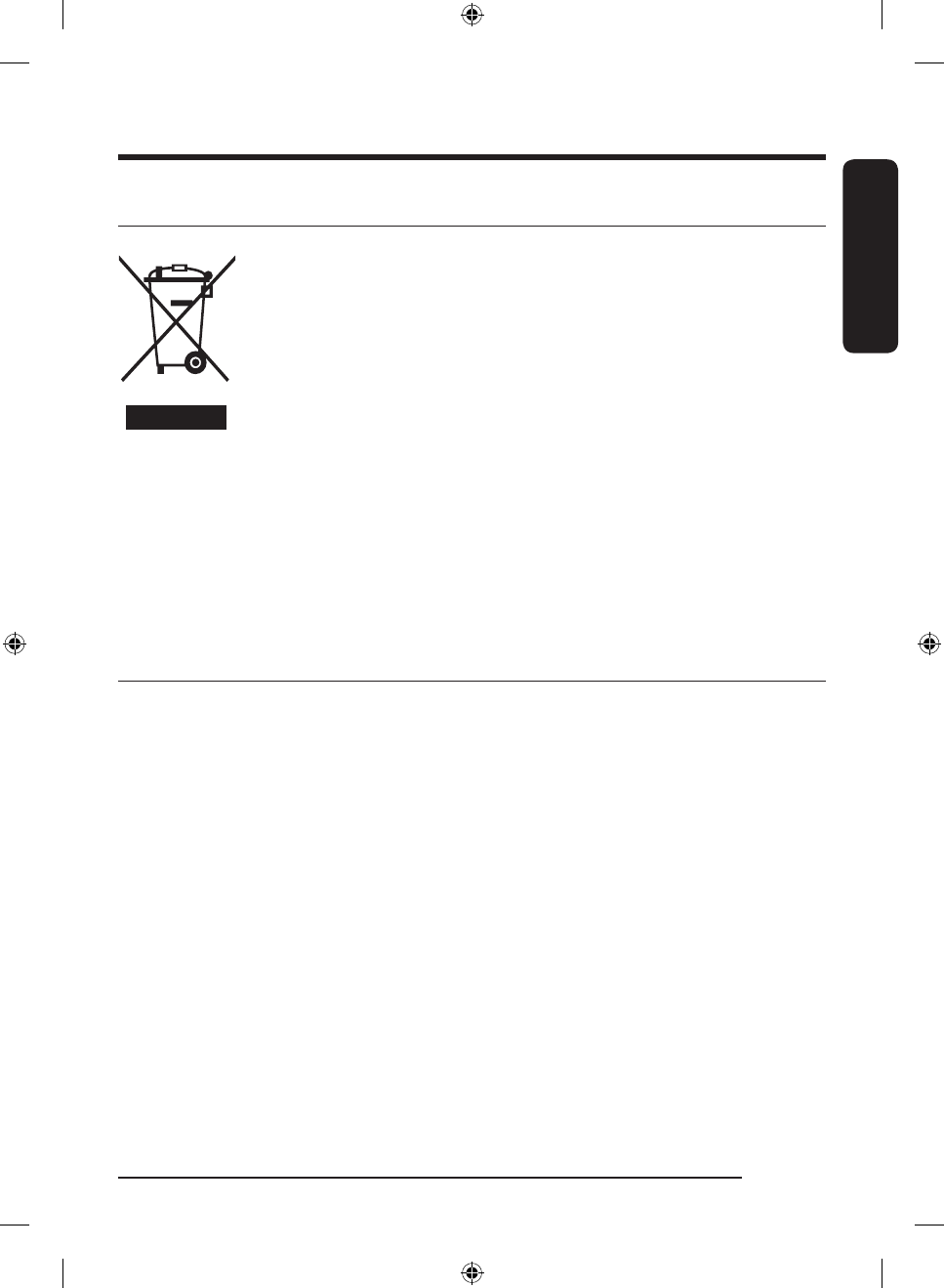
English
English 13
Instructions about the WEEE
Correct Disposal of This Product (Waste Electrical & Electronic Equipment)
(Applicable in countries with separate collection systems)
This marking on the product, accessories or literature indicates that the product and
its electronic accessories (e.g. charger, headset, USB cable) should not be disposed
of with other household waste at the end of their working life. To prevent possible
harm to the environment or human health from uncontrolled waste disposal, please
separate these items from other types of waste and recycle them responsibly to
promote the sustainable reuse of material resources.
Household users should contact either the retailer where they purchased this product,
or their local government office, for details of where and how they can take these
items for environmentally safe recycling.
Business users should contact their supplier and check the terms and conditions of
the purchase contract. This product and its electronic accessories should not be mixed
with other commercial wastes for disposal.
For information on Samsung’s environmental commitments and product regulatory obligations, e.g.
REACH, WEEE or Batteries, visit our sustainability page available via www.samsung.com
Ecodesign
For detailed instructions on installation and cleaning of the washing machine and ecodesign information
(according to (EU)2019/2023), visit the Samsung website (http://www.samsung.com), go to Support >
Support home, and then enter the model name.
Untitled-1 13 2021-02-03 10:43:12
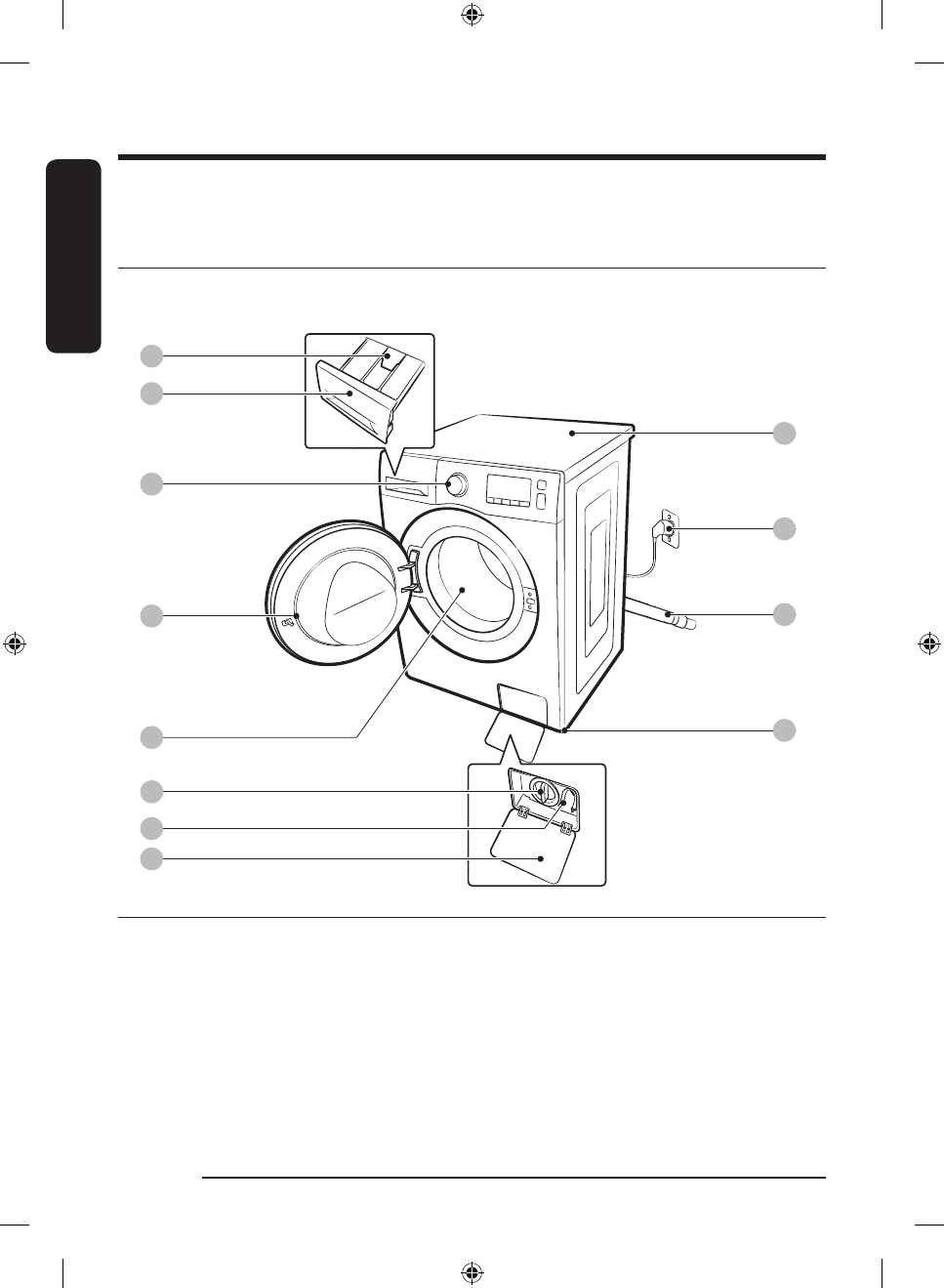
English
English14
Installation
Follow these instructions carefully to ensure proper installation of the washing machine and to prevent
accidents when doing laundry.
What’s included
Make sure all the parts are included in the product package. If you have a problem with the washing
machine or the parts, contact a local Samsung customer centre or the retailer.
01
02
12
11
10
09
03
04
06
08
07
05
01 Release lever 02 Detergent drawer 03 Control panel
04 Door 05 Drum 06 Debris filter
07 Emergency drain tube 08 Filter cover 09 Worktop
10 Power plug 11 Drain hose 12 Levelling feet
Untitled-1 14 2021-02-03 10:43:12
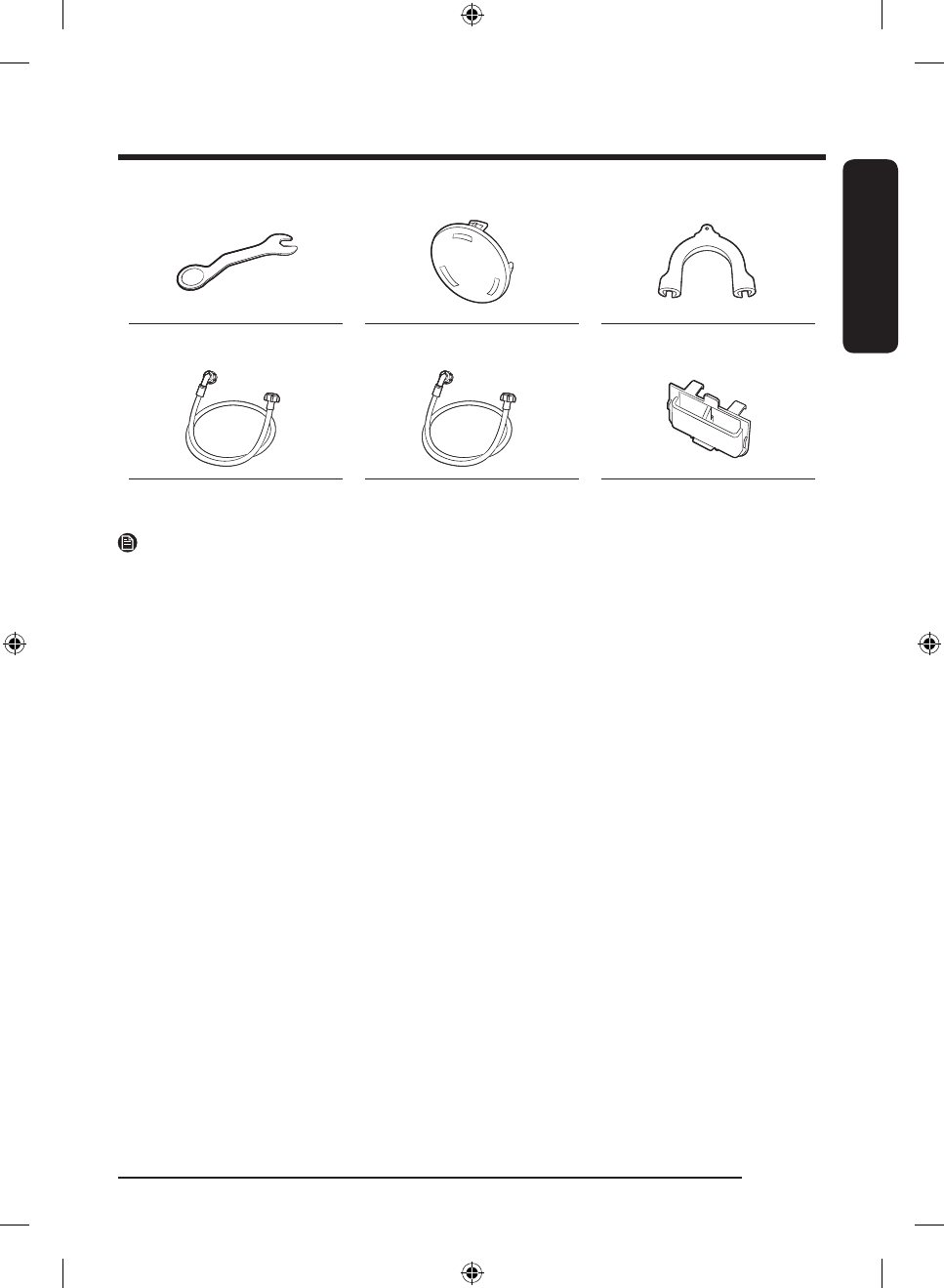
English
English 15
Spanner Bolt caps Hose guide
Cold water hose Hot water hose Liquid detergent guide
NOTE
• Spanner: For removing the shipping bolts and levelling the washing machine.
• Bolt caps: For covering the holes after removing the shipping bolts. The provided number of bolt caps (3
to 6) depends on the model.
• Hose guide: For hanging the drain hose in the drainpipe or wash-basin.
• Cold/Hot water hose: For supplying water to the washing machine. (Hot water hoses is for applicable
models only.)
• Liquid detergent guide: Insert it in the detergent compartment to use liquid detergent.
Accessories (not supplied)
• Stacking kit: SKK-DF
- Staking kit is required to stack a dryer on a washing machine.
Untitled-1 15 2021-02-03 10:43:13

English
Installation
English16
Installation requirements
Electrical supply and grounding
• AC 220-240 V / 50 Hz fuse or circuit breaker is
required.
• Use an individual branch circuit specific to the
washing machine.
To ensure proper grounding, the washing machine
comes with a power cord featuring a three-prong
grounding plug for use in a properly installed and
grounded outlet.
Check with a qualified electrician or service
person if you are not sure about the grounding.
Do not modify the provided plug. If it does not fit
the outlet, call a qualified electrician to install a
proper outlet.
WARNING
• Do NOT use an extension cord.
• Use only the power cord that comes with the
washing machine.
• Do NOT connect the ground wire to plastic
plumbing, gas lines, or hot water pipes.
• Improperly connected grounding conductors
may cause electric shock.
Water supply
A proper water pressure for this washing machine
is between 50 kPa and 1000 kPa. Water pressure
less than 50 kPa may cause the water valve not to
close completely. Or, it may take longer to fill the
drum, causing the washing machine to turn off.
Water taps must be within 120 cm from the rear
of the washing machine so that the provided inlet
hoses reach the washing machine.
To reduce the risk of leaks:
• Make sure water taps are easily accessible.
• Turn off the taps when the washing machine is
not in use.
• Check for any leaks at the water inlet hose
fittings on a regular basis.
CAUTION
Before using the washing machine for the first
time, check all connections at the water valve and
taps for any leaks.
Drain
Samsung recommends a standpipe in height of
60-90 cm. The drain hose must be connected
through the hose clip to the standpipe, and the
standpipe must fully cover the drain hose.
Untitled-1 16 2021-02-03 10:43:13
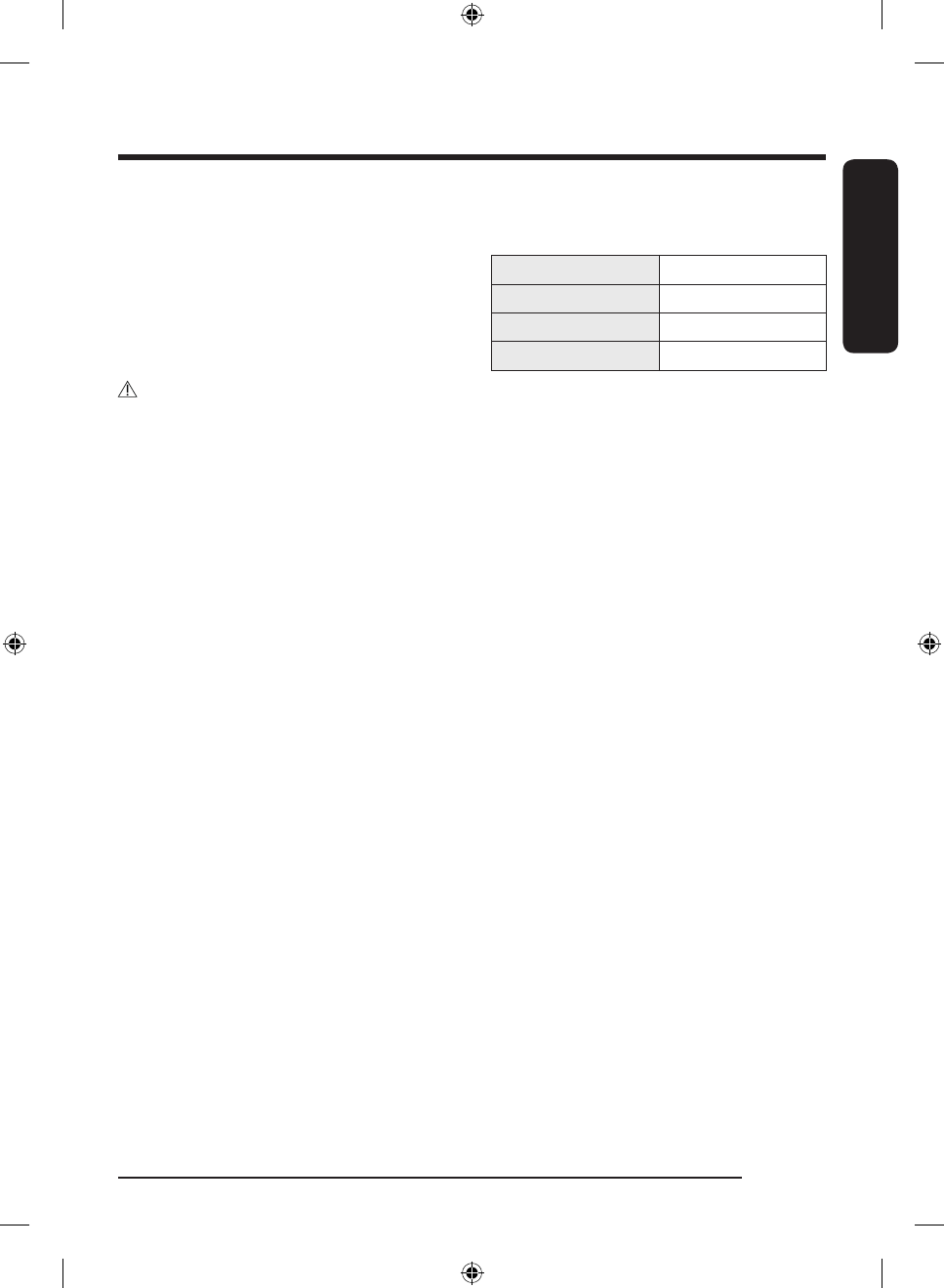
English
English 17
Flooring
For best performance, the washing machine must
be installed on a solid floor. Wood floors may need
to be reinforced to minimise vibration and/or
unbalanced loads. Carpeting and soft tile surfaces
are not a good resistance to vibrations and may
cause the washing machine to move slightly
during the spin cycle.
CAUTION
Do NOT install the washing machine on a platform
or a poorly supported structure.
Water temperature
Do not install the washing machine in areas where
water may freeze as the washing machine always
retains some water in its water valves, pumps,
and/or hoses. Frozen water left in the connection
parts may cause damage to belts, the pump, and
other components of the washing machine.
Alcove or closet installation
Minimum clearance for stable operation:
Sides 25 mm
Top 25 mm
Rear 50 mm
Front 550 mm
If both the washing machine and a dryer are
installed in the same location, the front of the
alcove or closet must have at least a 550 mm
unobstructed air opening. Your washing machine
alone does not require a specific air opening.
Untitled-1 17 2021-02-03 10:43:13

English
Installation
English18
Step-by-step installation
STEP 1 Select a location
Location requirements:
• Solid, level surface without carpeting or flooring that may obstruct ventilation
• Away from direct sunlight
• Adequate room for ventilation and wiring
• The ambient temperature is always higher than the freezing point (0 °C)
• Away from a heat source
STEP 2 Remove the shipping bolts
Unpack the product package and remove all shipping bolts.
NOTE
Number of shipping bolts may differ depending on the model.
WARNING
• Packaging materials can be dangerous to children. Dispose all packaging material (plastic bags,
polystyrene, etc.) out of children’s reach.
• To avoid injury, cover the holes with bolt caps after removing the shipping bolts. Do not move the
washing machine without the shipping bolts in place. Assemble the shipping bolts before moving the
washing machine to another location. Keep the shipping bolts in a safe place for future use.
Untitled-1 18 2021-02-03 10:43:13
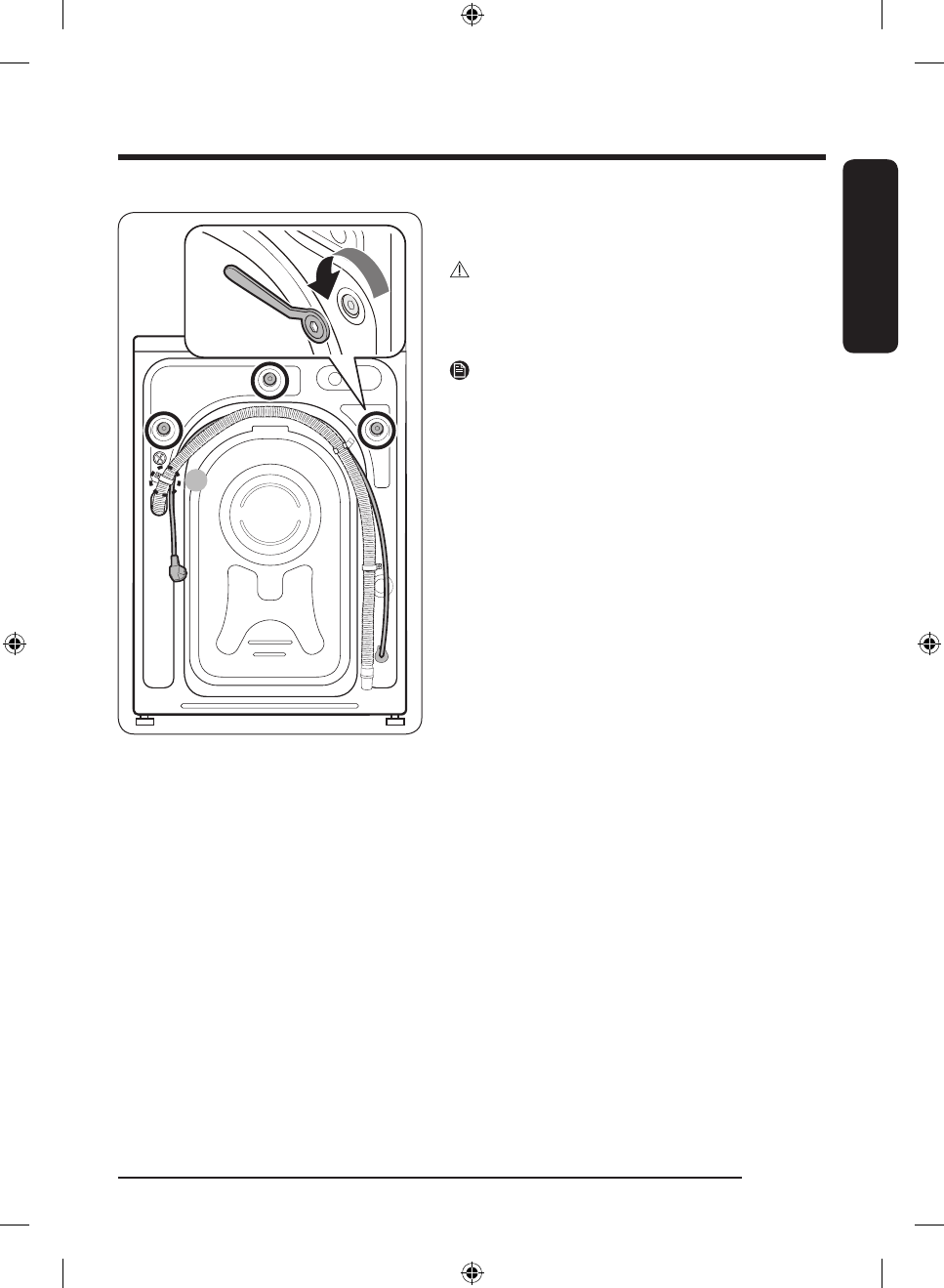
English
English 19
A
1. Locate the shipping bolts (marked with circle in the
figure) on the rear side of the washing machine.
CAUTION
Do not remove the screw (A) that fixes the hose clip.
2. Using the supplied spanner, loosen all the shipping
bolts by turning them counterclockwise.
NOTE
You must keep the shipping bolts for future use.
Untitled-1 19 2021-02-03 10:43:14
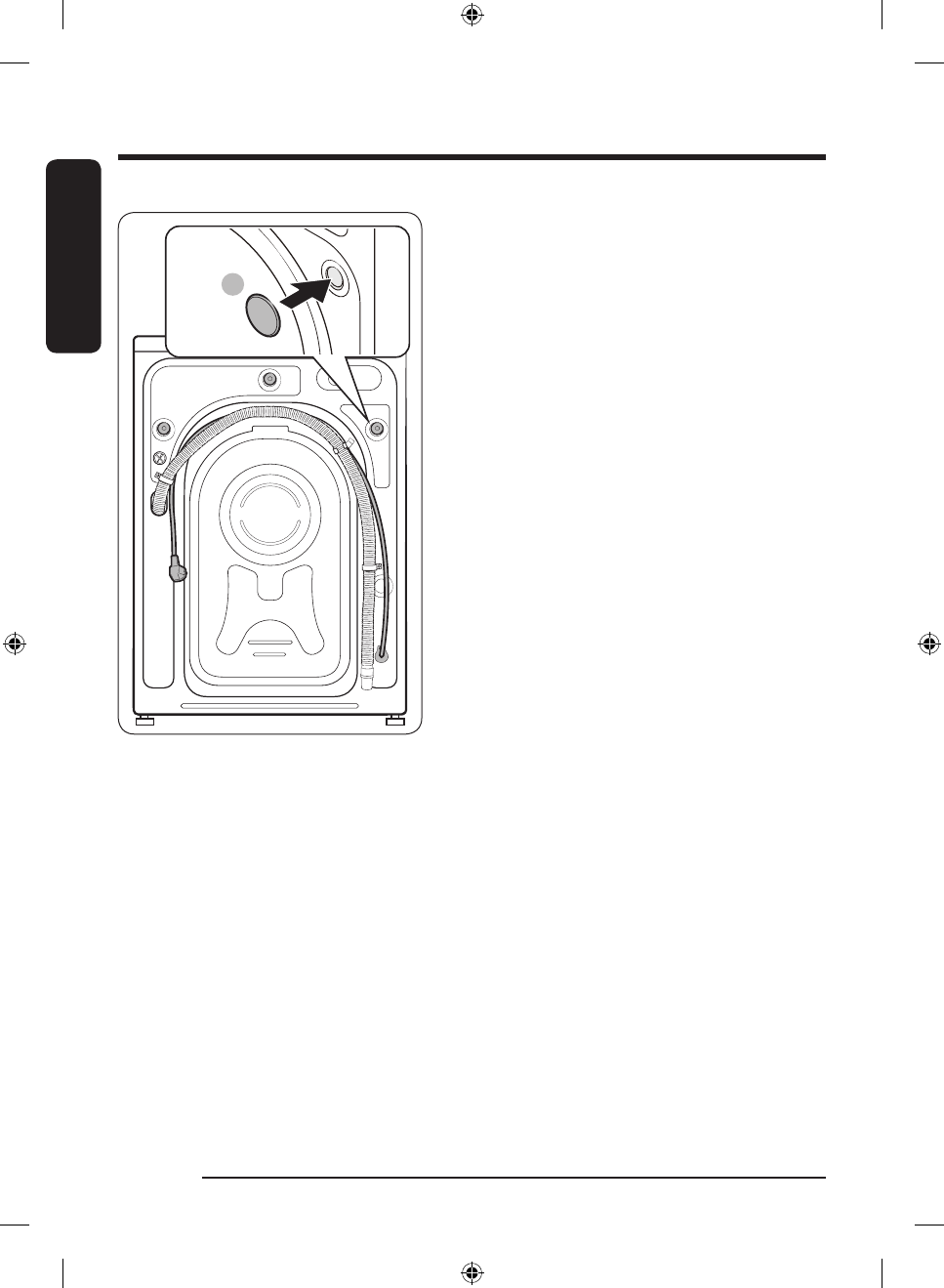
English
Installation
English20
B
3. Insert the bolt caps (B) to the holes (marked with
circle in the figure).
Untitled-1 20 2021-02-03 10:43:14
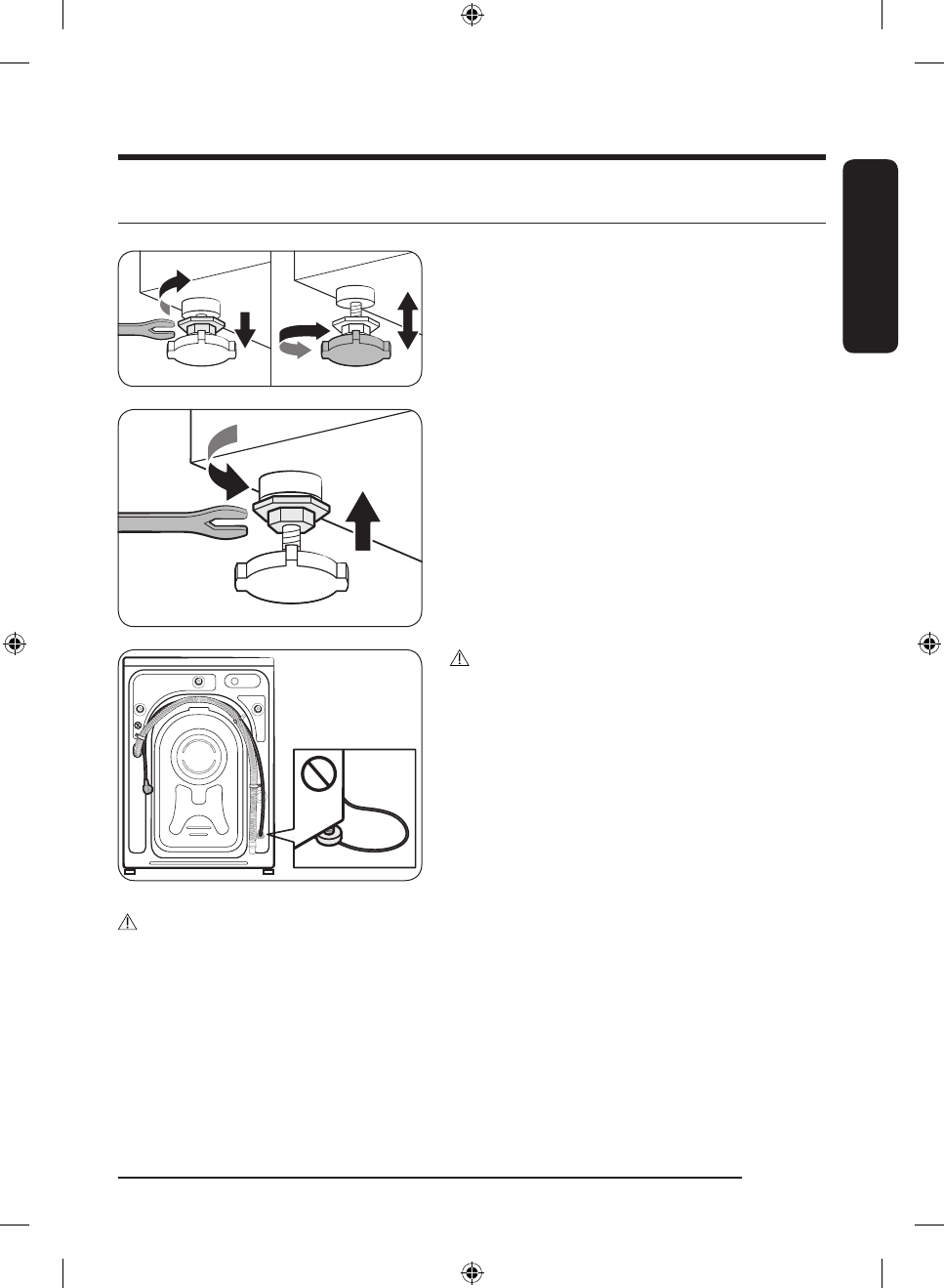
English
English 21
STEP 3 Adjust the levelling feet
1. Gently slide the washing machine into position.
Excessive force may damage the levelling feet.
2. Level the washing machine by manually adjusting the
levelling feet.
3. When levelling is complete, tighten the nuts using
the spanner.
CAUTION
When installing the product make sure the levelling feet
is not pressing the power cord.
CAUTION
Make sure all the levelling feet are seating on the floor surface to avoid the washing machine from moving
or generating noise due to vibration Then, check if the washing machine is not rocking. If the washing
machine is not rocking, tighten the nuts.
Untitled-1 21 2021-02-03 10:43:14
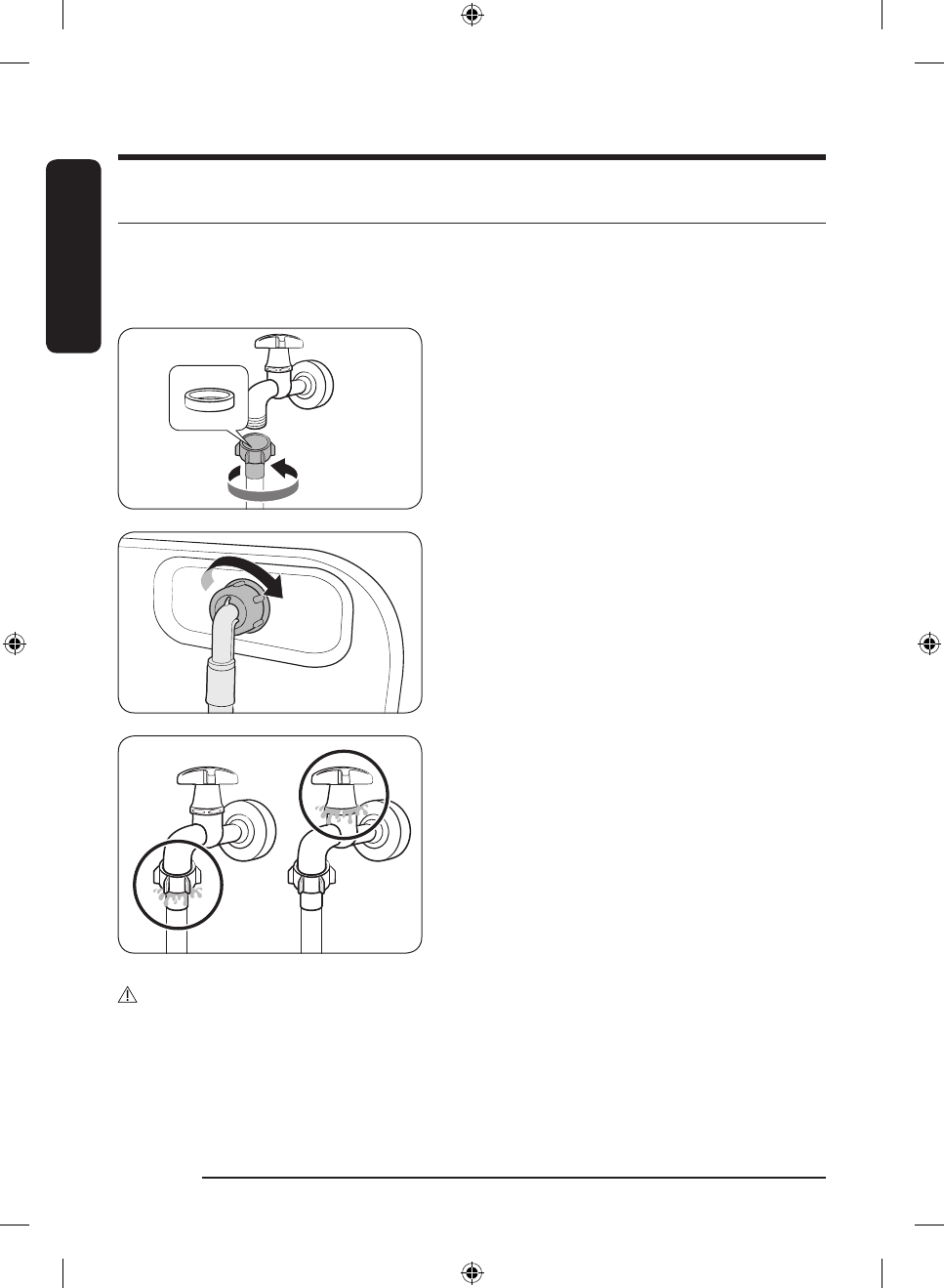
English
Installation
English22
STEP 4 Connect the water hose
The provided water hose may differ depending on the model. Please follow the instruction according to the
provided water hose.
Connecting to a threaded water tap
1. Connect the water hose to the water tap, and then
turn the connector clockwise as shown.
2. Connect the other end of the water hose to the inlet
valve on the back of the washing machine. Turn the
hose clockwise to tighten.
3. Open the water tap and check if there are any leaks
around the connection areas. If there are water leaks,
repeat the steps above.
WARNING
If there is a water leak, stop operating the washing machine and disconnect from the electrical supply.
Then, contact a local Samsung service centre in case of a leak from the water hose, or contact a plumbing
technician in case of a leak from the water tap. Otherwise, this may cause electric shock.
Untitled-1 22 2021-02-03 10:43:15
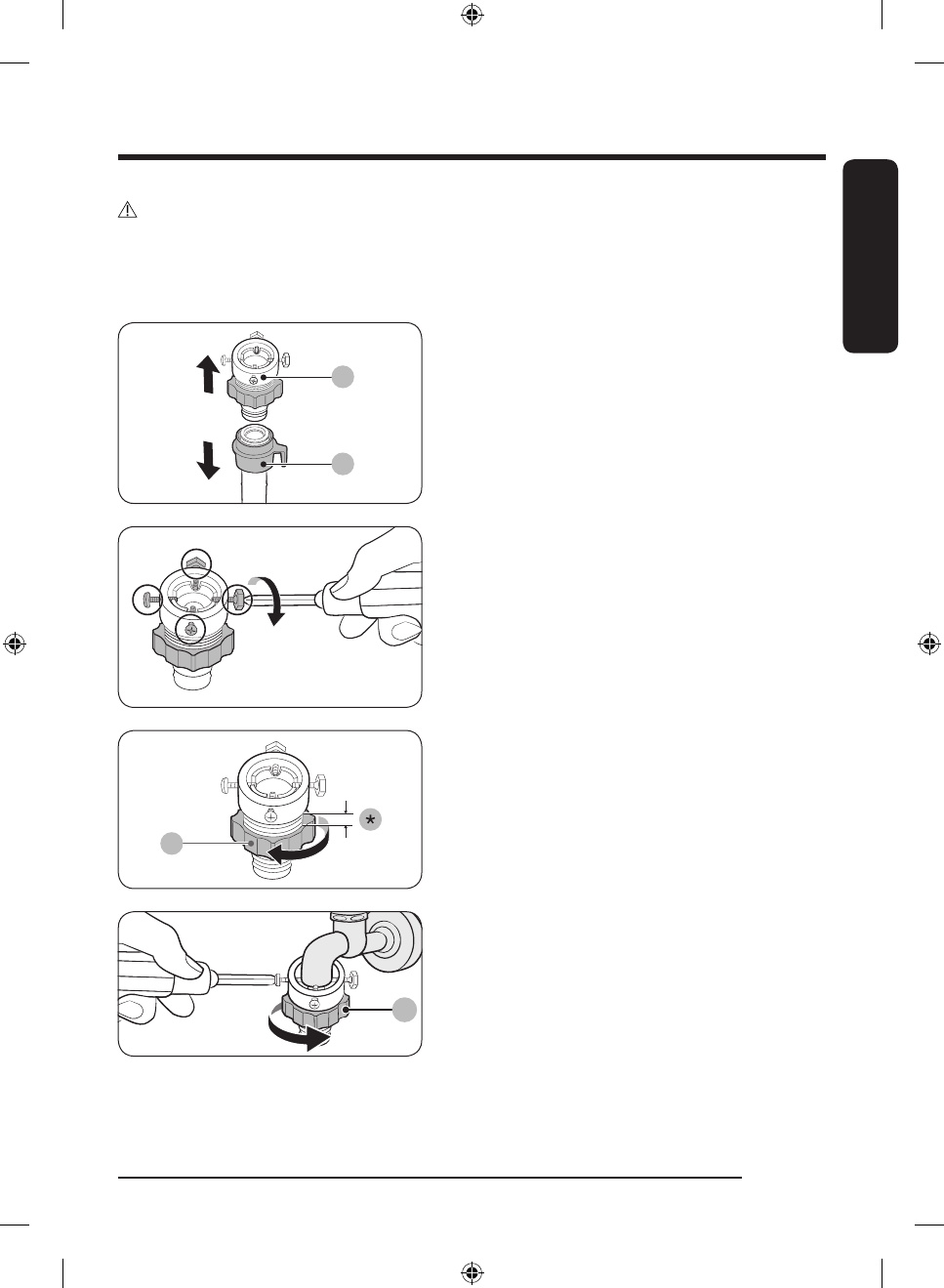
English
English 23
CAUTION
Do not stretch the water hose by force. If the hose is too short, replace the hose with a longer, high-
pressure hose.
Connecting to a non-threaded water tap
A
B
1. Remove the adaptor (A) from the water hose (B).
2. Use a Phillips screwdriver to loosen four screws on
the adaptor.
C
3. Hold the adaptor and turn part (C) in the arrow
direction to loosen it by 5 mm (*).
C
4. Insert the adaptor onto the water tap, and then
tighten the screws while lifting the adaptor.
5. Turn part (C) in the arrow direction to tighten it.
Untitled-1 23 2021-02-03 10:43:15
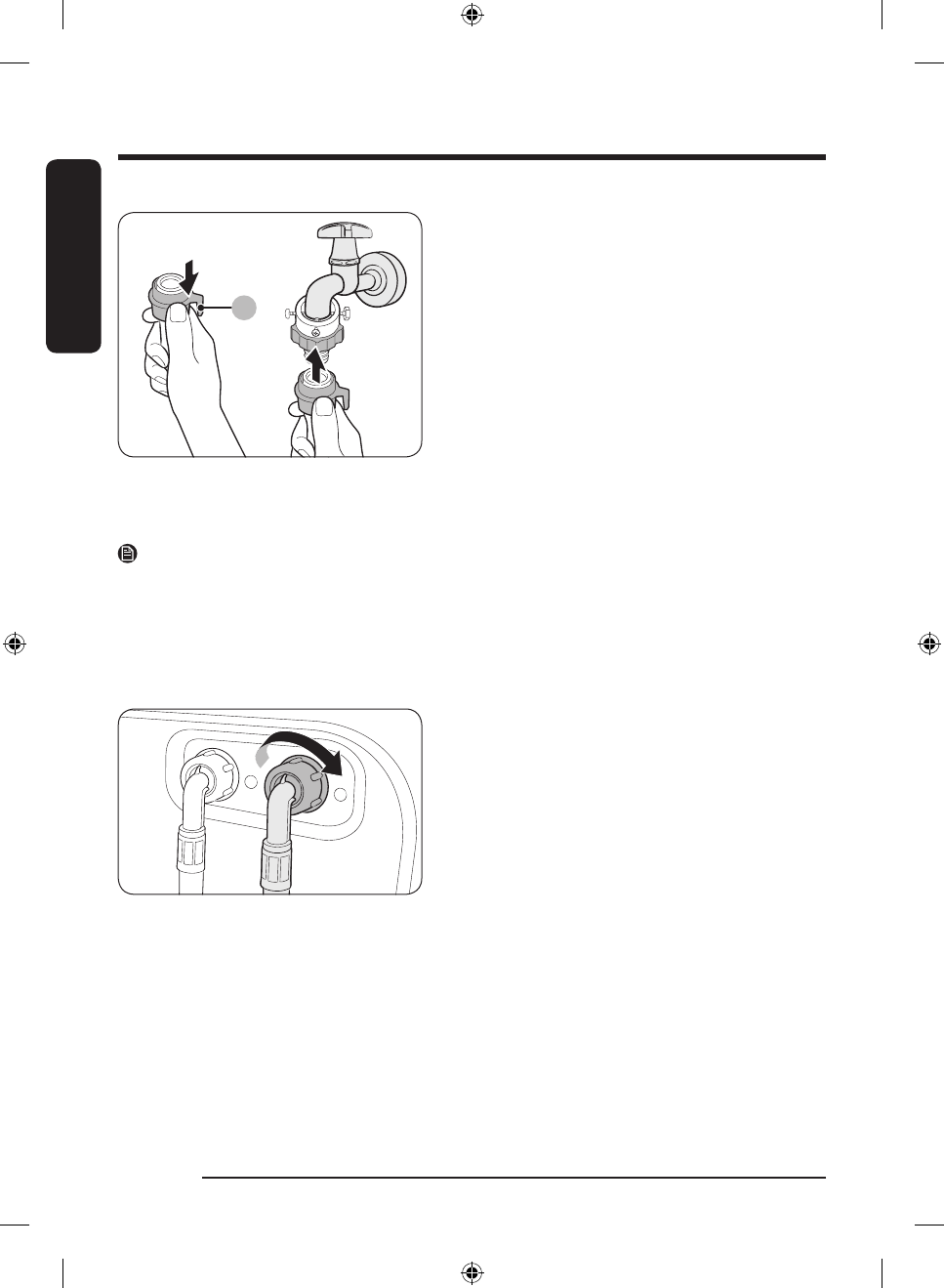
English
Installation
English24
D
6. While pulling down part (D) on the water hose,
connect the water hose to the adaptor. Then, release
part (D). The hose fits into the adaptor with a clicking
sound.
7. To complete connecting the water hose, see 2 and 3
on the “Connecting to a threaded water tap” section.
NOTE
• After connecting the water hose to the adaptor, check if it is connected properly by pulling the water
hose downwards.
• Use a popular type of water taps. If the tap is square-shaped or too big, remove the spacer ring before
inserting the tap into the adaptor.
For models with an additional hot water inlet:
1. Connect the red end of the hot water hose to the hot
water inlet on the back of the machine.
2. Connect the other end of the hot water hose to the
hot water tap.
Untitled-1 24 2021-02-03 10:43:16
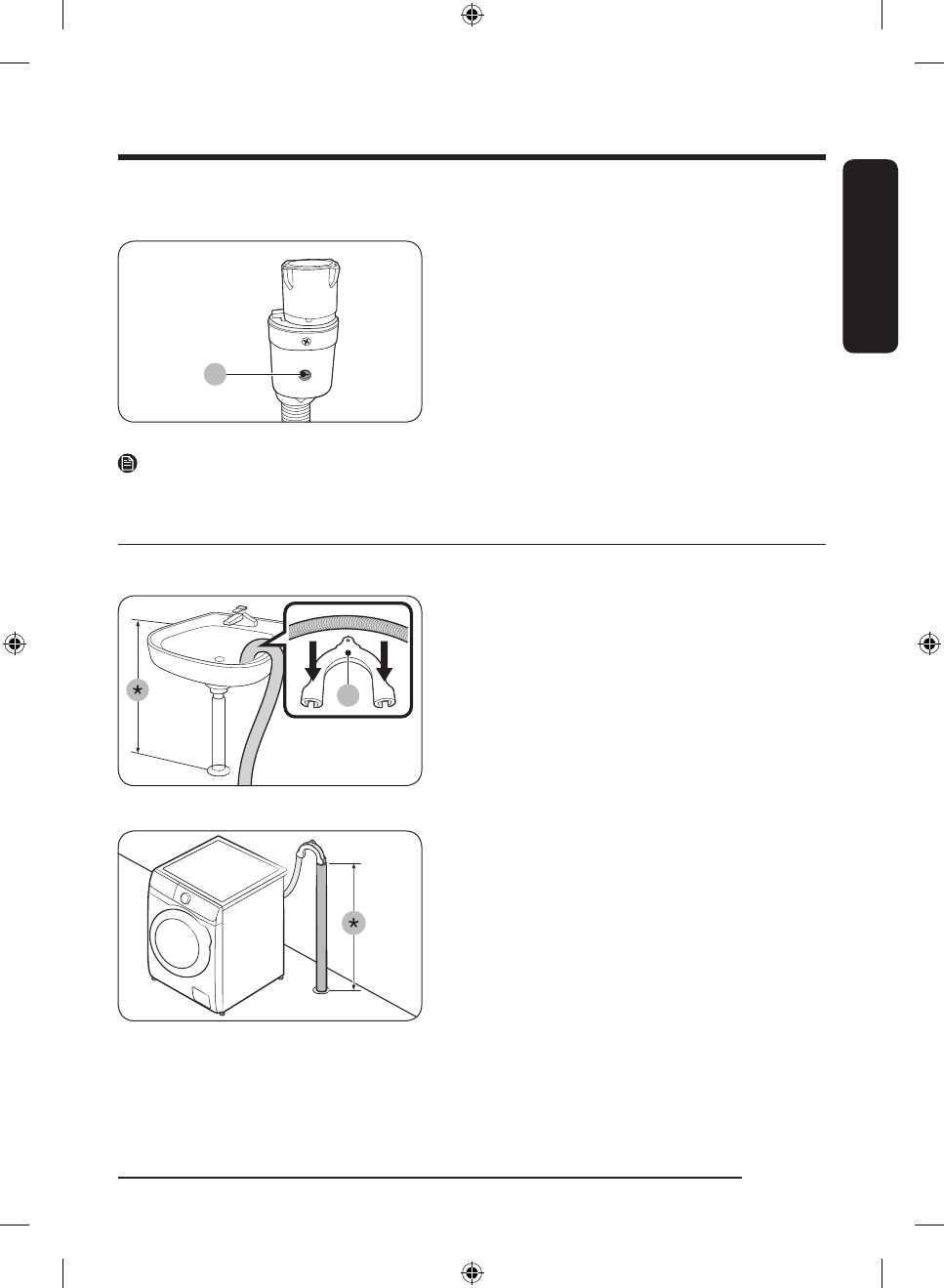
English
English 25
Aqua hose (applicable models only)
A
The aqua hose alerts users of a risk of water leaks.
It senses the water flow and turns red on the centre
indicator (A) in case of a leak.
NOTE
The end of the aqua stop hose must be fitted to the water tap and not the machine.
STEP 5 Position the drain hose
The drain hose can be positioned in three ways:
A
Over the edge of a wash basin
The drain hose must be placed at a height of between
60 cm and 90 cm (*) from the floor. To keep the spout of
the drain hose bent, use the supplied plastic hose guide
(A). Secure the guide to the wall using a hook to ensure
stable drainage.
In a drain pipe
The drain pipe should be between 60 cm and 90 cm high
(*). It is advisable to use a 65 cm high vertical pipe.
• To ensure the drain hose stays in position, use the
plastic hose guide provided (see the figure).
• To prevent the siphoning of water flow during
drainage, make sure to insert the drain hose 15 cm in
the drain pipe.
• To prevent the drain hose from moving around,
secure the hose guide to the wall.
Drain standpipe requirements:
• Minimum diameter of 5 cm
• Minimum carry-away capacity of 60 litres per minute
Untitled-1 25 2021-02-03 10:43:16
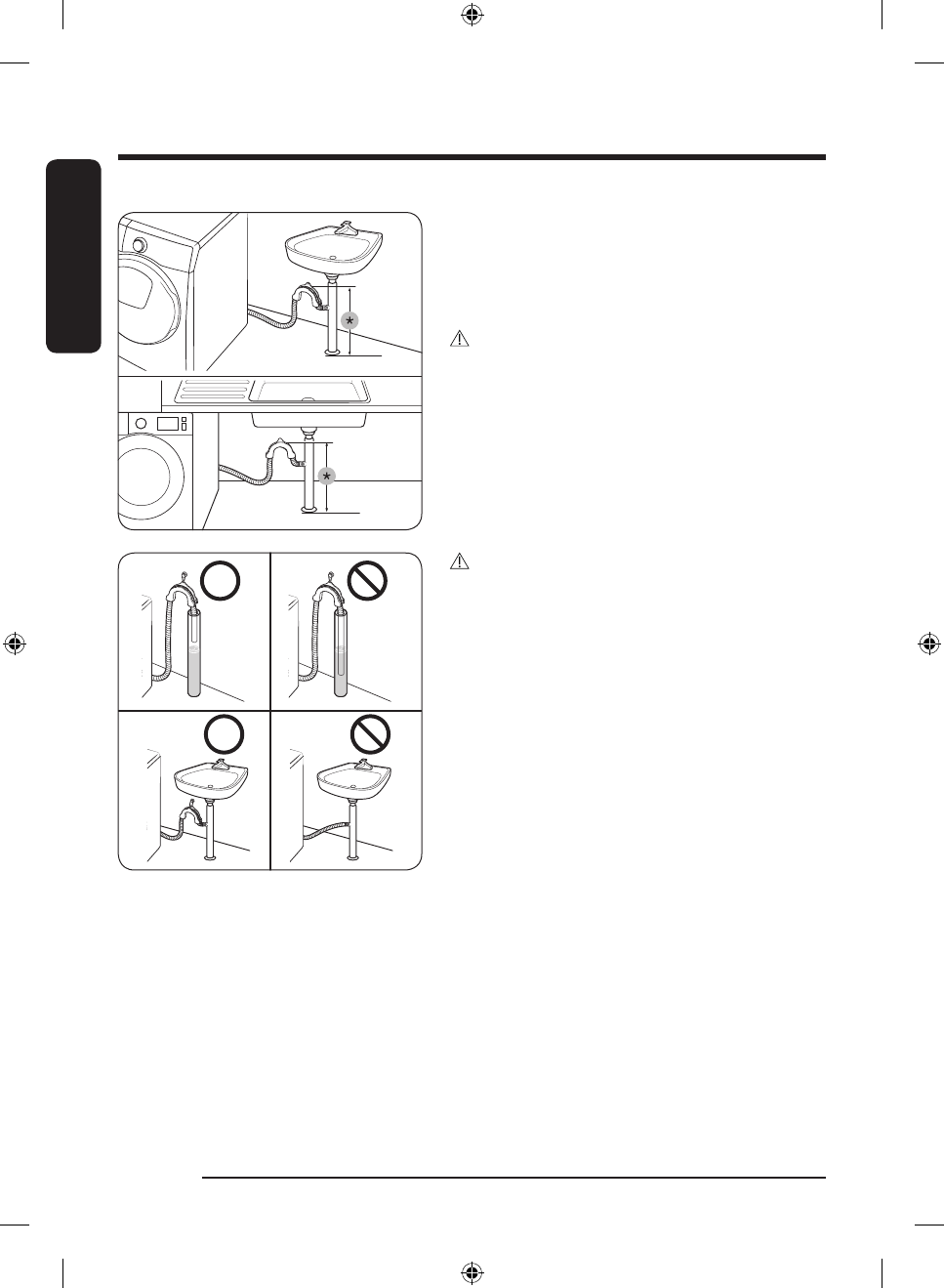
English
Installation
English26
In a sink drain pipe branch
The drain pipe branch mush be above the sink siphone
so that the end of the hose is at least 60 cm above the
ground.
(*) : 60 cm
CAUTION
Remove the lid on the sink drain pipe branch before
connecting the drain pipe to it.
CAUTION
Do not put the drain hose in places of stagnant water
or ponding. The water may flow back to the washing
machine.
Untitled-1 26 2021-02-03 10:43:17
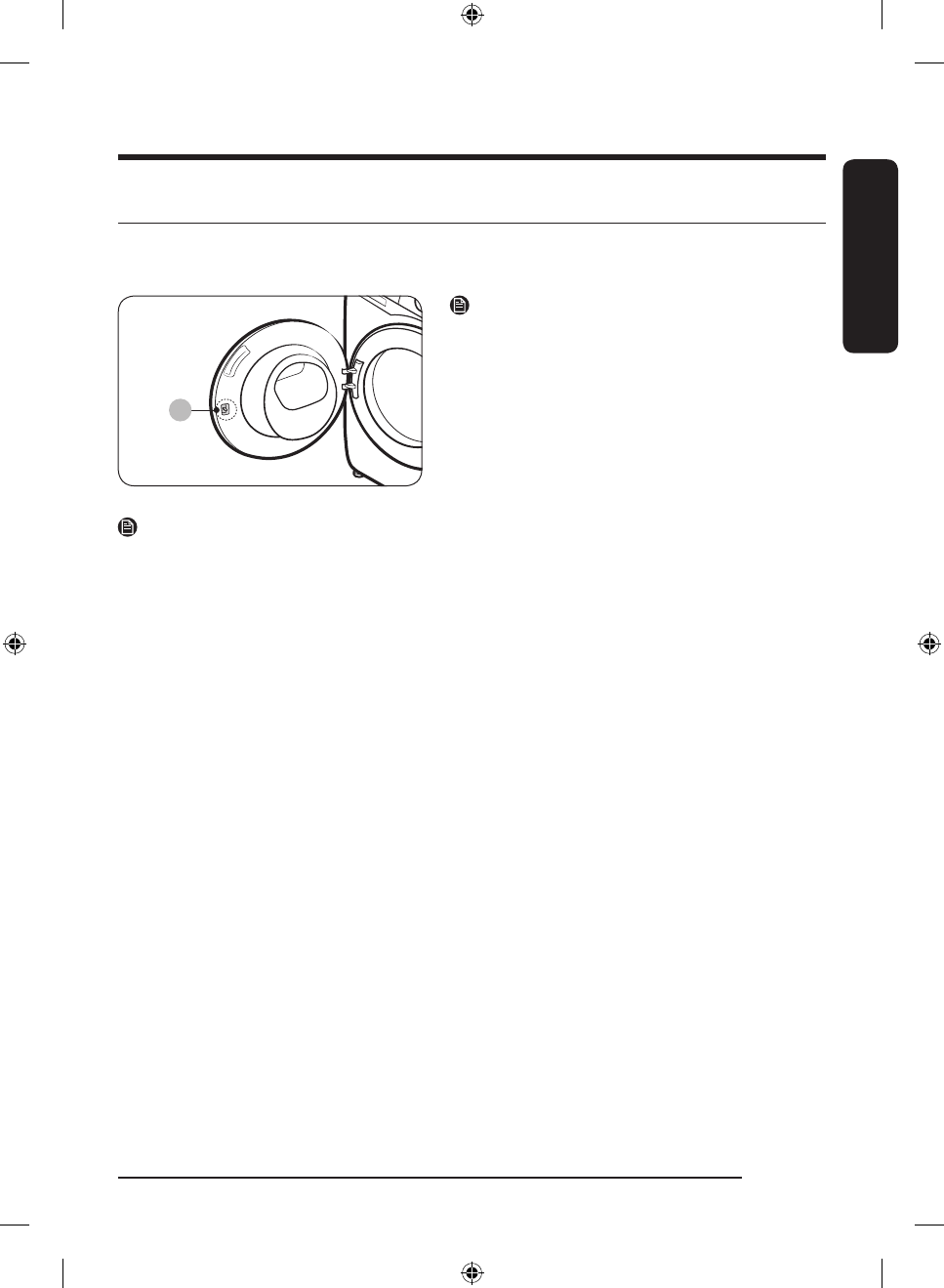
English
English 27
STEP 6 Power on
Plug the power cord into a wall socket that is correctly rated, grounded, and protected by a fuse or circuit
breaker. Then, press
Power to turn on the washing machine.
A
NOTE
Door latch (lever) (A) is originally designed to be loose
a little, because it may make the door latch be inserted
into the door more easily.
NOTE
If the door is locked during installation, plug the power cord, and turn on the power. The door will unlock.
Untitled-1 27 2021-02-03 10:43:17

English
English28
Before you start
NOTE
Before doing your laundry for the first time, you must run a complete wash cycle without any items in the
drum.
Initial settings
Run Calibration (recommended)
Calibration ensures accurate weight detection by the washing machine. Make sure the drum is empty
before running Calibration.
1. Power off, and then power on the washing machine.
2. Hold down Temp. and Delay End simultaneously for 3 seconds to enter Calibration mode. The “Cb”
message appears.
3. Press Start/Pause to run the Calibration cycle.
4. The drum will rotate for about 3 minutes. (The direction of the drum rotation may differ depending on
the model.)
5. When the cycle is complete, “0” appears on the display and the washing machine will turn off
automatically.
6. The washing machine is now ready for use.
Laundry guidelines
STEP 1 Sort
Sort the laundry according to these criteria:
• Care Label: Sort the laundry into cottons, mixed fibres, synthetics, silks, wools, and rayon.
• Colour: Separate whites from colours.
• Size: Mixing different sized items together in the drum improves the washing performance.
• Sensitivity: Wash delicate items separately using an Easy Iron option for pure, new woollen items,
curtains, and silk items. Check the labels on the items.
NOTE
Make sure to check the care label on the clothing, and sort them accordingly before starting the wash.
Untitled-1 28 2021-02-03 10:43:17

English
English 29
STEP 2 Empty pockets
Empty all the pockets of your laundry items
• Metal objects such as coins, pins, and buckles on clothing may damage other laundry items as well as
the drum.
Turn clothing with buttons and embroideries inside out
• If pants or jacket zippers are open while washing, the drum may be damaged. Zippers should be closed
and fixed with a string.
• Clothing with long strings may become entangled with other clothes. Make sure to tie the strings
before starting the wash.
STEP 3 Use a laundry net
• Brassieres (water washable) must be placed in a laundry net. Metal parts of the brassieres may break
through and tear other laundry items.
• Small, light clothing such as socks, gloves, stockings, and handkerchiefs may become caught around
the door. Place them inside a fine laundry net.
• Do not wash the laundry net by itself without other laundry. This may cause abnormal vibrations that
could move the washing machine and result in injury.
STEP 4 Prewash (if necessary)
Select the Prewash option for the selected cycle if the laundry is heavily soiled. When selecting the
Prewash option, make sure to put powder-type detergent into the main wash compartment.
STEP 5 Determine the load capacity
Do not overload the washing machine. Overloading may cause the washing machine to not wash properly.
For the load capacity for the type of clothing, see page 38.
NOTE
When washing bedding or bedding covers, the wash time may be lengthened or the spin efficiency may be
reduced. For bedding or bedding covers, the recommended maximum spin cycle speed is 800 rpm, and the
load capacity is 2.0 kg or less.
CAUTION
Unbalanced laundry may reduce the spinning performance.
Untitled-1 29 2021-02-03 10:43:17

English
Before you start
English30
STEP 6 Apply a proper detergent type
The type of detergent depends on the type of fabric (cotton, synthetic, delicate items, wool), colour,
wash temperature, and degree of soiling. Always use “low suds” laundry detergent, which is designed for
automatic washing machines.
NOTE
• Follow the detergent manufacturer’s recommendations based on the weight of the laundry, the degree
of soiling, and the hardness of the water in your local area. If you are not sure about the water hardness,
contact a local water authority.
• Do not use detergent that tends to be hardened or solidified. This detergent may remain after the rinse
cycle, blocking the drain outlet.
CAUTION
When washing wool using the WOOL cycle, use only a neutral liquid detergent. If used with the WOOL
cycle, powder detergent may remain on the laundry and discolour the laundry.
Untitled-1 30 2021-02-03 10:43:17

English
English 31
Laundry capsules
To get the best results from using laundry capsules, please follow these instructions.
1. Put the capsule in the bottom of the empty drum
towards the rear.
2. Put the laundry in the drum on top of the capsule.
CAUTION
For cycles using cold water or cycles that complete in less than one hour, it is recommended to use a liquid
detergent. Otherwise, the capsule may not dissolve completely.
Untitled-1 31 2021-02-03 10:43:18
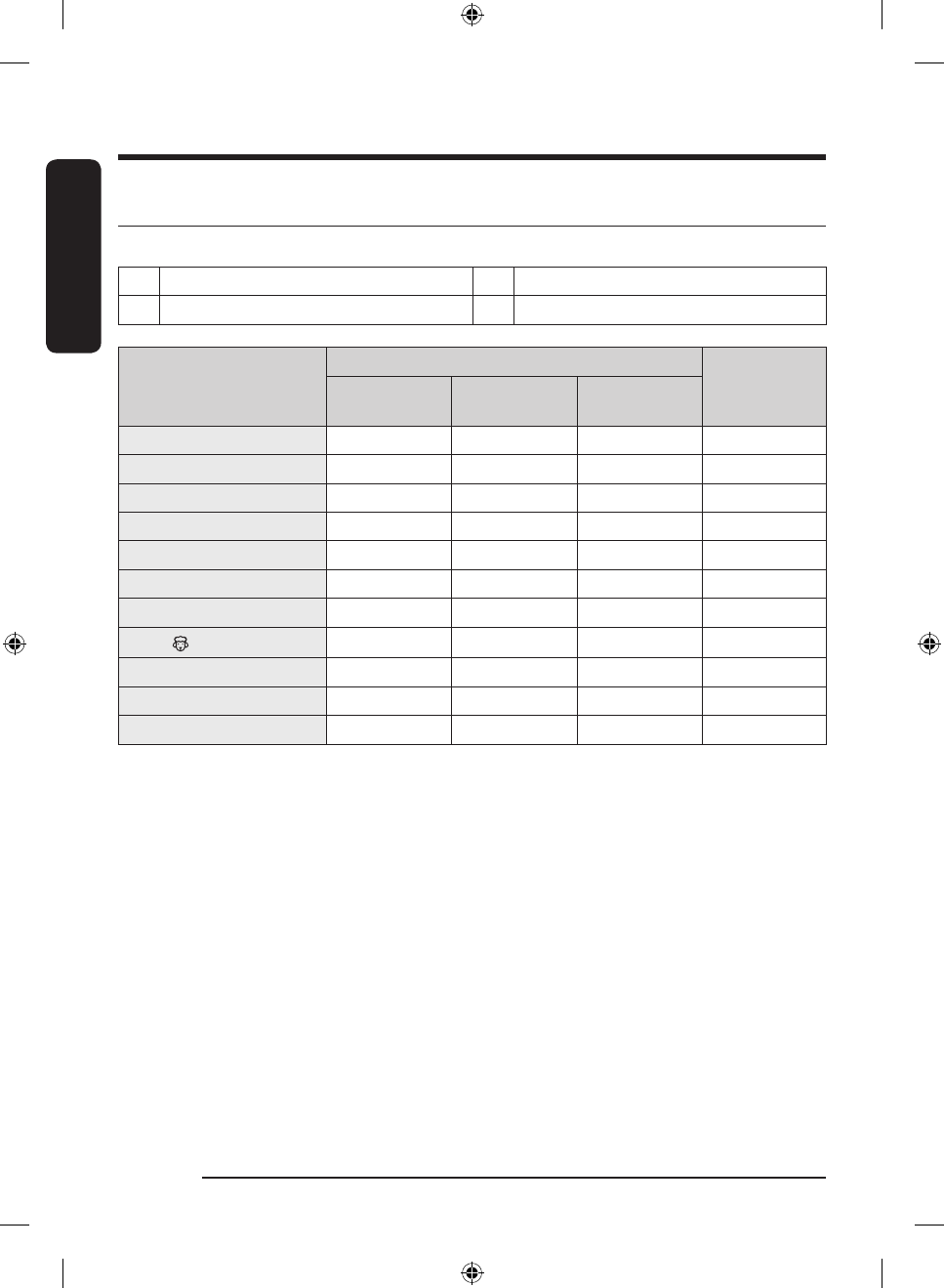
English
Before you start
English32
Detergent recommendation
The recommendations apply to the temperature ranges given in the cycle chart.
Recommended Liquid detergent only
– Not recommended Powder detergent only
Cycle
Detergent
Temp. (°C)
Universal
Delicates and
woollens
Specialist
ECO 40-60 – – 40~60
COTTON – – Cold~90
SYNTHETICS – – Cold~60
HYGIENE STEAM – – Cold~90
15' QUICK WASH – – Cold~40
MIXED LOAD – – Cold~60
DELICATES – – Cold~40
WOOL
– – Cold~40
INTENSE COLD – – Cold
COLOURS – – Cold~40
BEDDING – – Cold~40
Untitled-1 32 2021-02-03 10:43:18
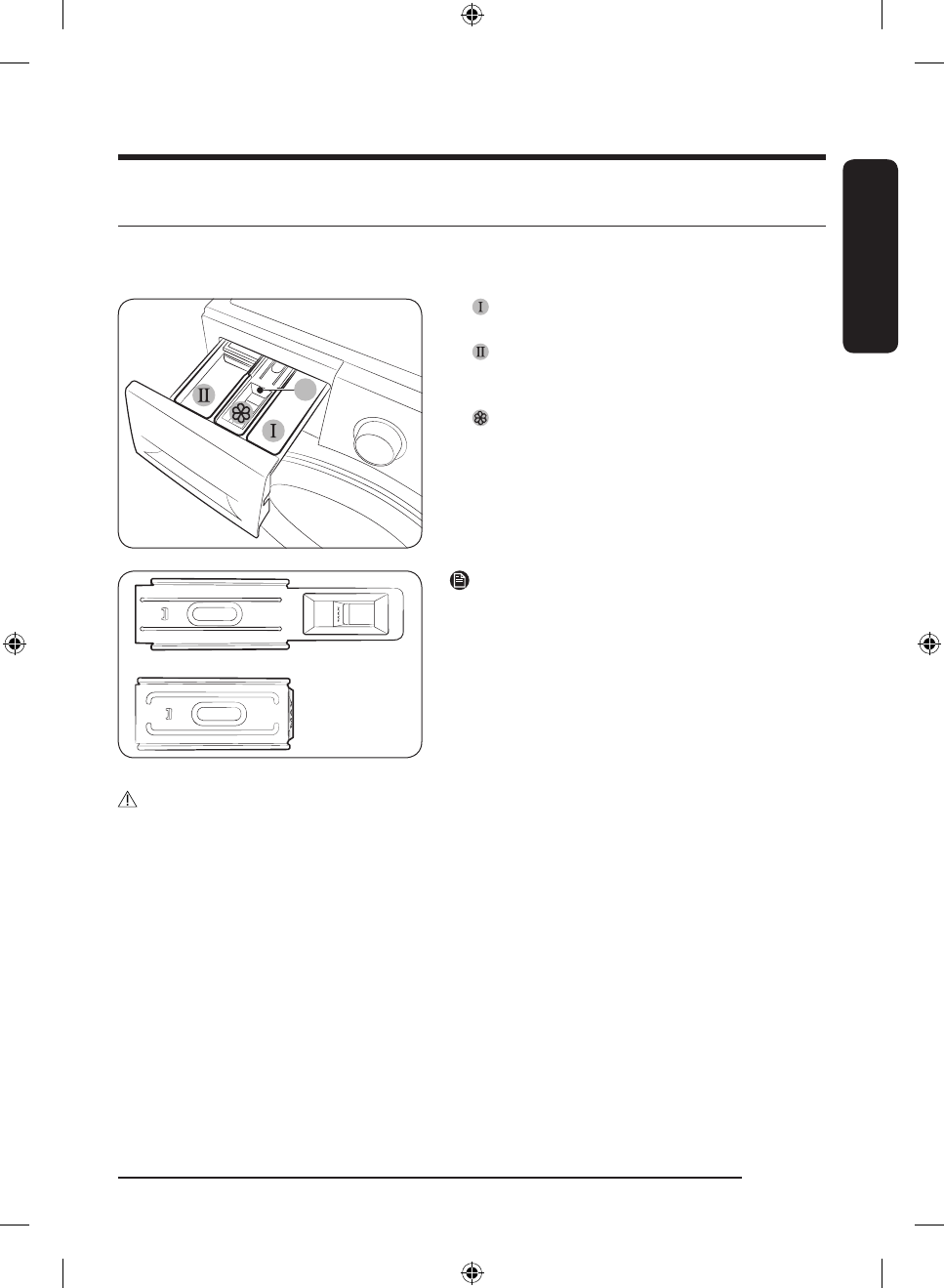
English
English 33
Detergent drawer guidelines
The washing machine provides a three-compartment dispenser: the left compartment for the main wash,
the centre for fabric softeners, and the right for the preliminary wash.
A
1. Prewash compartment: Apply prewash detergent
or starch.
2. Main-wash compartment: Apply main-wash
detergent, water softener, soaking detergent, bleach,
and/or stain removers.
3. Softener compartment: Apply additives such as
fabric softener. Do not exceed the max line (A).
NOTE
The actual appearance of the softener guide may differ
with the model.
CAUTION
• Do not open the detergent drawer while the washing machine is operating.
• Do not use the following types of detergent:
- Tablet or capsule types
- Ball or net types
• To prevent the compartment clogging, concentrated or highly-enriched agents (fabric softener or
detergent) must be diluted with water before being applied.
• When Delay End is selected, do not apply detergent directly into the drum. Otherwise, this may
discolour the laundry. Use the detergent drawer when Delay End is selected.
• Do not use any cleaning agents for cleaning the drum. Chemical residue in the drum deteriorates the
washing performance.
Untitled-1 33 2021-02-03 10:43:19
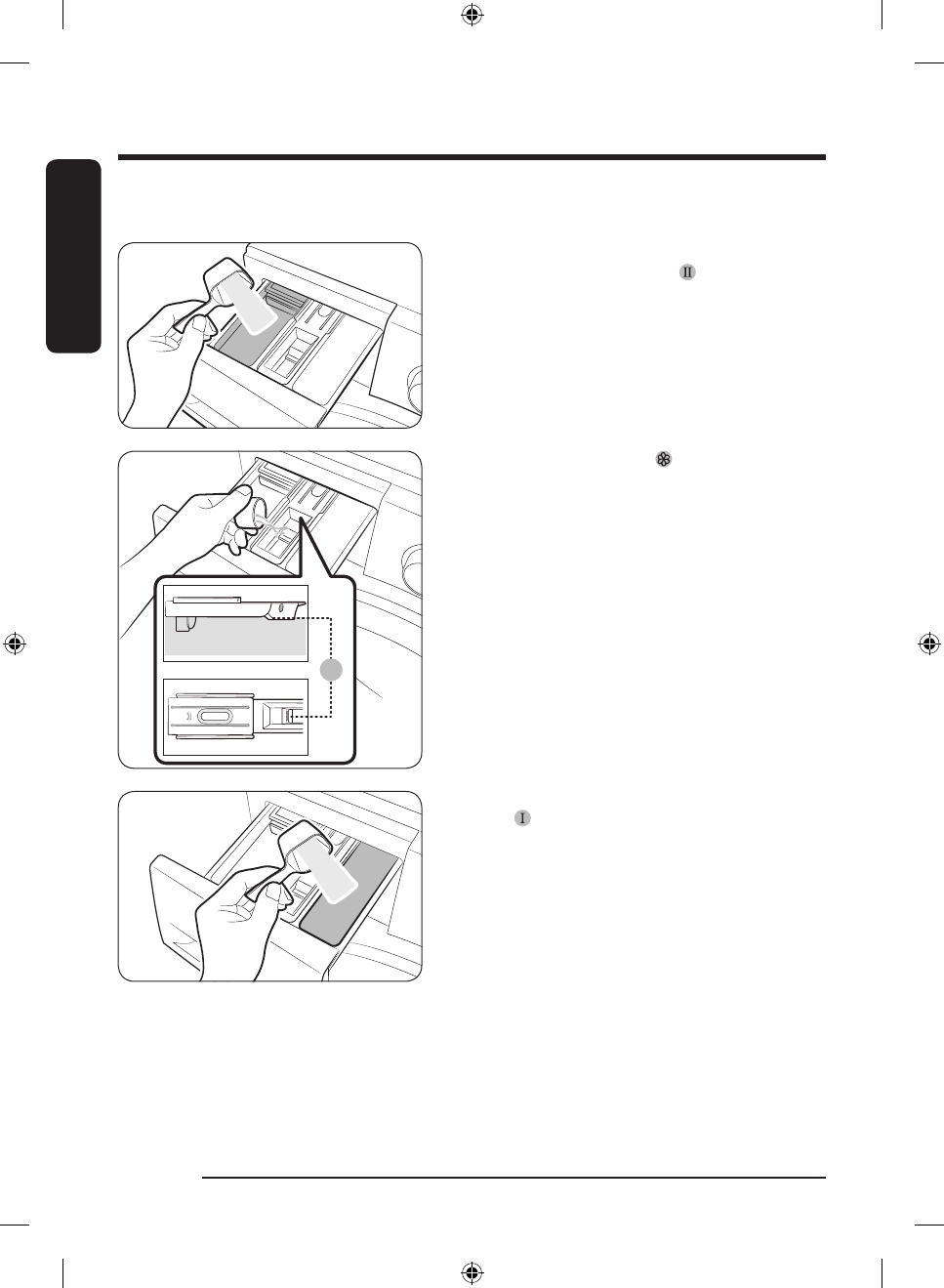
English
Before you start
English34
To apply washing agents to the detergent drawer
1. Slide open the detergent drawer.
2. Apply laundry detergent to the main-wash
compartment as instructed or recommended by the
manufacturer. To use liquid detergent, see page 35.
A
3. Apply fabric softener to the softener
compartment. Do not exceed the max line (A).
Softener is dispensed into the wash during the final
rinse.
4. If you want to prewash, apply prewash detergent
to the prewash compartment as instructed or
recommended by the manufacturer.
5. Close the detergent drawer.
Untitled-1 34 2021-02-03 10:43:19
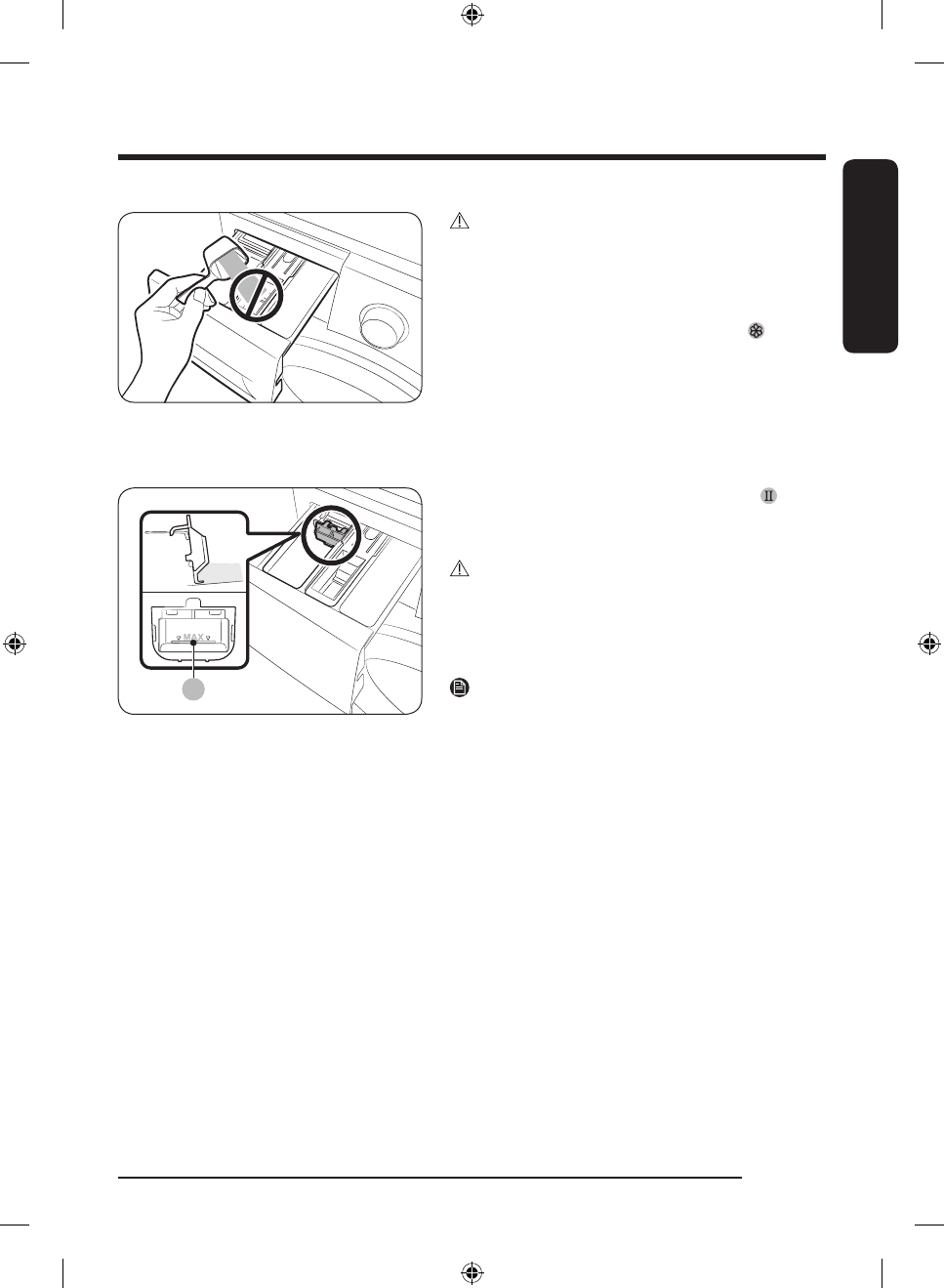
English
English 35
CAUTION
• Do not apply powder detergent to the liquid
detergent guide.
• Concentrated fabric softener must be diluted with
water before applied.
• Do not apply main-wash detergent to the softener
compartment.
To use liquid detergent (applicable models only)
A
First insert the provided liquid container in the main-
wash compartment. Then, apply liquid detergent to the
container below the marked max line (A).
CAUTION
• Do not exceed the max line that is marked inside the
container.
• Remove the liquid container if using powder
detergent.
NOTE
• Insert the liquid detergent guide only after you
remove the detergent drawer from the washing
machine by pressing release lever (A).
• After a wash, some liquid detergent may remain in
the detergent drawer.
Untitled-1 35 2021-02-03 10:43:20
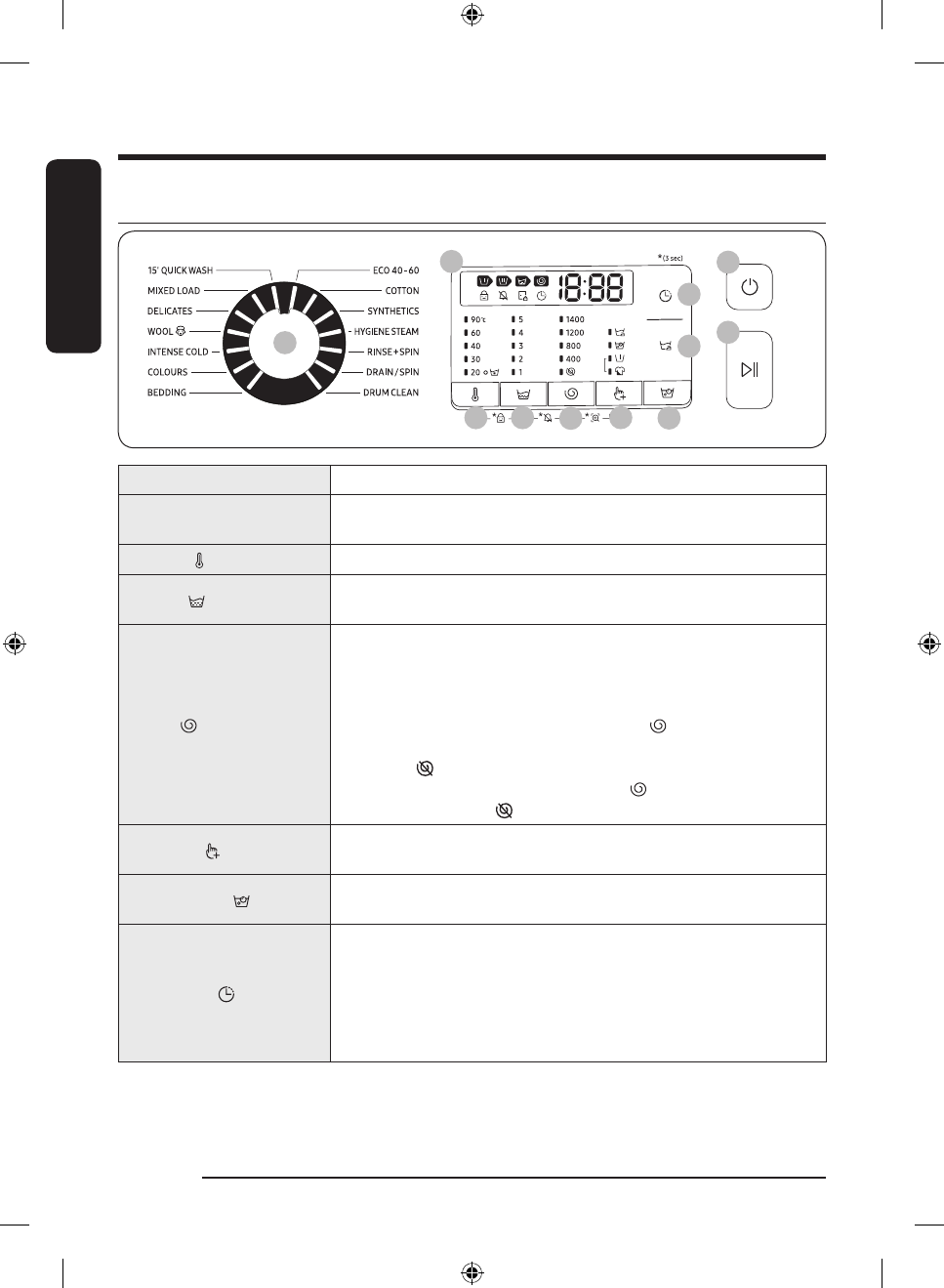
English
English36
Operations
Control panel
01
02
03 04
05
06
07
08
09
10
11
01 Cycle Selector Turn the dial to select a cycle.
02 Display
The display shows current cycle information and estimated time
remaining, or an information code when a problem occurs.
03
Temp.
Press to change the water temperature for the current cycle.
04
Rinse
Press to change the rinse count for the current cycle. You can set the
rinse count to a max of 5, depending on the cycle.
05
Spin
Press to change the spinning speed for the current cycle.
•
Rinse Hold (No indicator): The final rinse process is suspended so
that the laundry remains in the water. To unload the laundry, run a
drain or spin process.
- To use the Rinse Hold option, press Spin repeatedly until all
the Spin option indicators turn off.
• No Spin : The drum does not spin after the final drain process.
- To use the No Spin option, press Spin repeatedly until the
option indicator ( ) turns on.
06
Options
Press to select an option from Intensive, Prewash, and Rinse+. Press
again to deselect.
07
Bubble Soak
Press to activate/deactivate the Bubble Soak function. This function
helps remove a wide variety of stubborn stains.
08 Delay End
Delay End lets you set the end time of the current cycle. Based on your
settings, the start time of the cycle will be determined by the machine’s
internal logic. For example, this setting is useful for programming your
machine to finish a wash at the time you normally return home from
work.
• Press to choose a preset unit of hours.
Untitled-1 36 2021-02-03 10:43:20
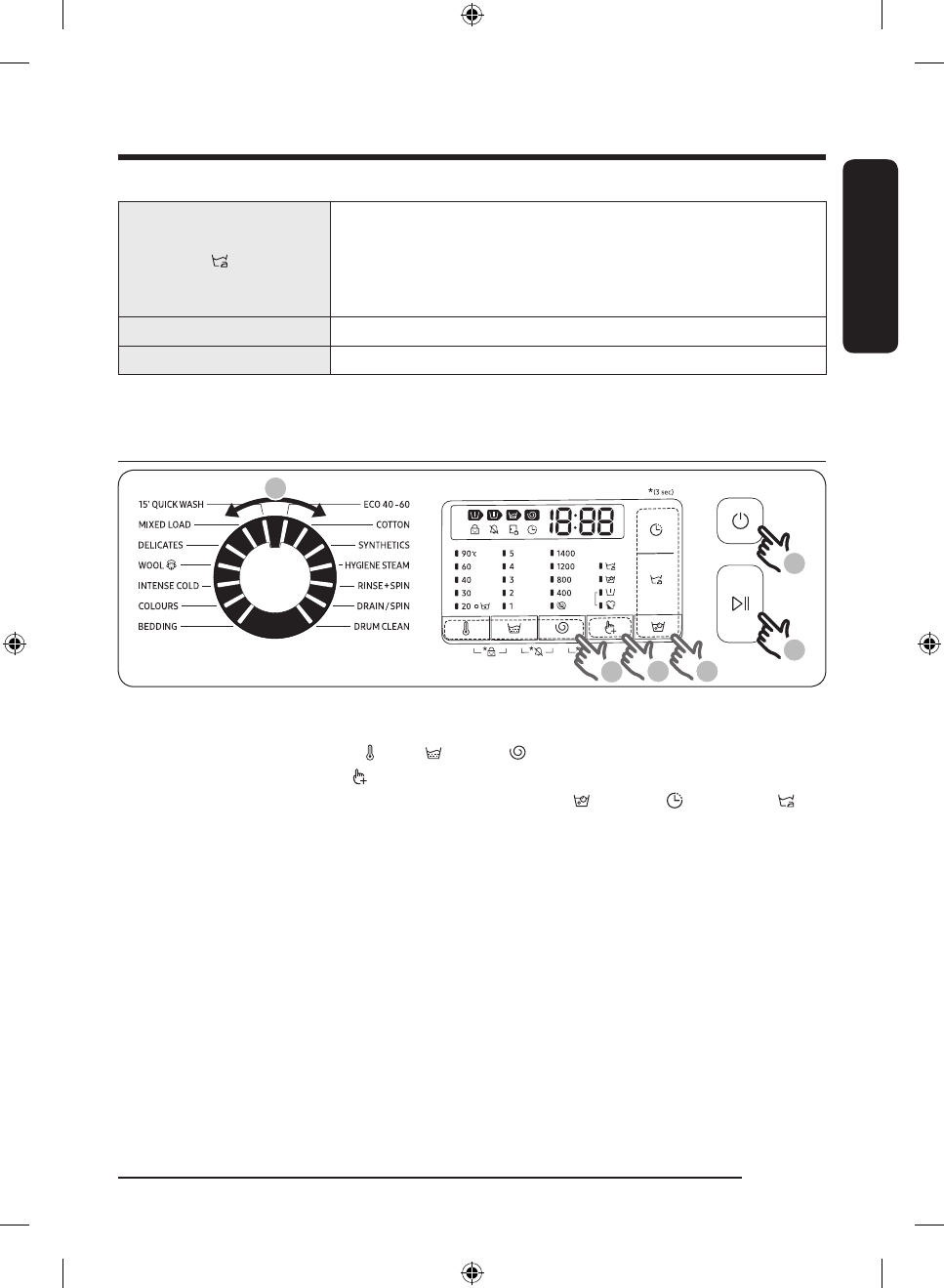
English
English 37
09 Easy Iron
Press to prepare your laundry so that it can be easily ironed by reducing
the wrinkles during the spin cycle.
• Easy Iron is only available for the following wash cycles: ECO 40-60,
COTTON, SYNTHETICS, HYGIENE STEAM, MIXED LOAD, INTENSE
COLD, COLOURS, BEDDING
10
Power Press to turn on/off the washing machine.
11 Start/Pause Press to start or stop operation.
*(3 sec) : Press and hold for 3 seconds.
Simple steps to start
1
6
2
3
4 5
1. Press Power to turn on the washing machine.
2. Turn the Cycle Selector to select a cycle.
3. Change the cycle settings (Temp. , Rinse , and Spin ) as necessary.
4. To add an option, press Options . Use the button again to choose a preferred item.
5. The machine provides the easy to access buttons for Bubble Soak , Delay End and Easy Iron for
your convenience. If you want to use one of these options, press the corresponding button.
6. Press Start/Pause.
To change the cycle during operation
1. Press Start/Pause to stop operation.
2. Select a different cycle.
3. Press Start/Pause again to start the new cycle.
Untitled-1 37 2021-02-03 10:43:21
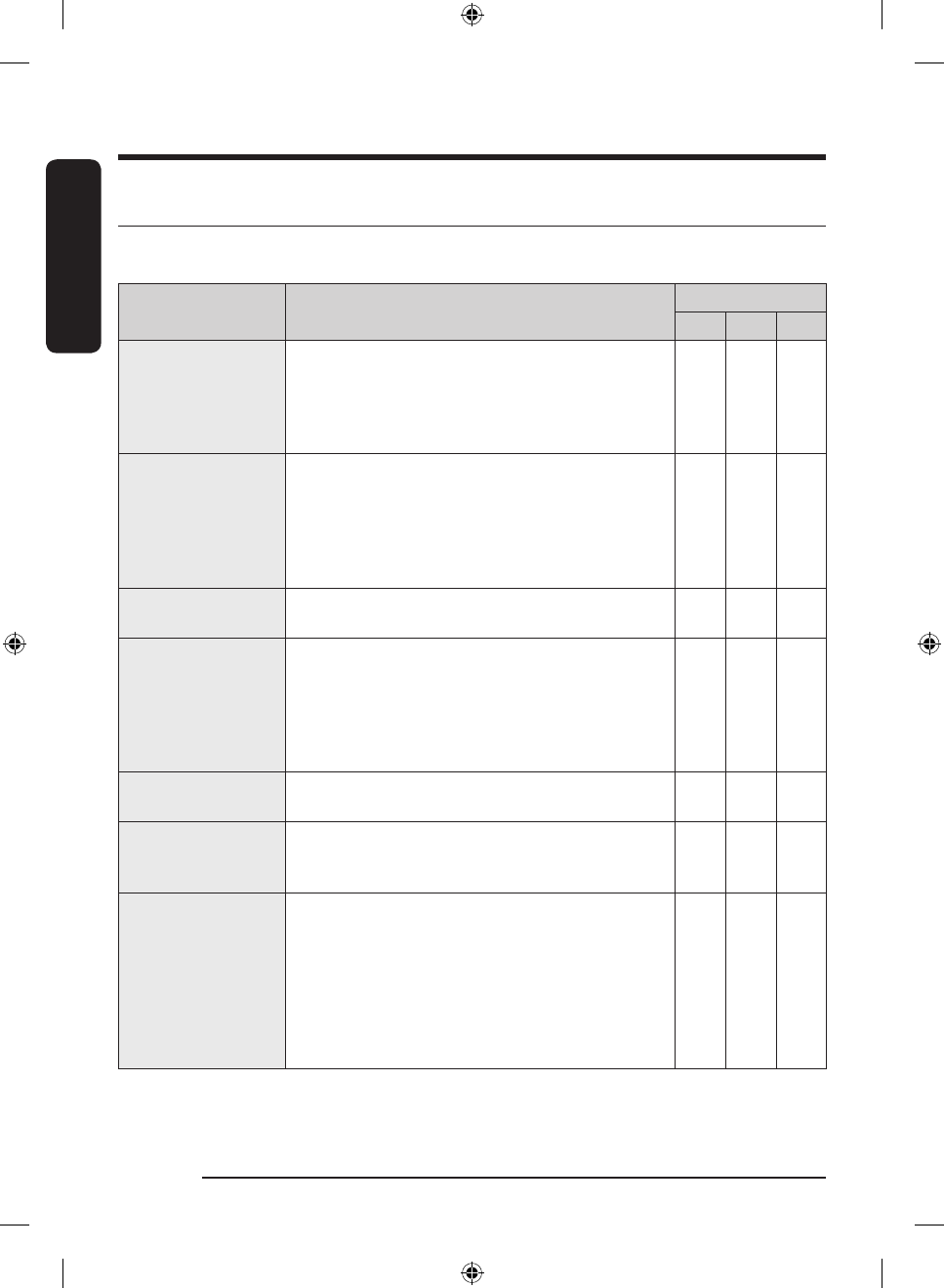
English
Operations
English38
Cycle overview
Standard cycles
Cycle Description
Max load (kg)
9 kg 8 kg 7 kg
ECO 40-60
• For cleaning normally soiled cotton items which are
declared to be washable at 40 °C or 60 °C, together
in the same cycle. This cycle is used to assess the
compliance with the EU Ecodesign legislation.
• This cycle is set as a default.
Max Max Max
COTTON
• For cottons, bed linens, table linens, underwear,
towels, or shirts. The washing time and the rinse
count are automatically adjusted according to the
load.
• For cleaning lightly soiled cotton items at a nominal
temperature of 20 °C.
Max Max Max
SYNTHETICS
• For fabrics that are made of polyester(diolen,
trevira), polyamide (perlon, nylon), or the like.
4 4 4
HYGIENE STEAM
• Cotton and linen fabric which have been in direct
contact with the skin, e.g. underwear.
• For optimum hygiene results select a temperature of
60 °C or above.
• Steam cycles feature allergy care and bacteria
elimination (sterilize).
4 4 4
RINSE+SPIN
• Featuring an additional rinse process after applying
fabric softener to the laundry.
Max Max Max
DRAIN/SPIN
• For draining the water inside the drum and running
an additional spin process to effectively remove
moisture from laundry.
Max Max Max
DRUM CLEAN
• Cleans the drum by removing dirt and bacteria from
it.
• Perform once every 40 washes with no detergent or
bleach applied. Notification message appears after
every 40 washes.
• Make sure the drum is empty.
• Do not use any cleaning agents for cleaning the
drum.
- - -
Untitled-1 38 2021-02-03 10:43:21

English
English 39
Cycle Description
Max load (kg)
9 kg 8 kg 7 kg
15' QUICK WASH
• For lightly soiled items in less than 2.0 kg that you
want to wash quickly.
• Use less than 20 g of detergent. Using more than 20
g of detergent may leave detergent residue.
• For liquid detergent, use a maximum of 20 ml of
liquid detergent.
2 2 2
MIXED LOAD • For mixed load consisting of cotton and synthetic. 4 4 4
DELICATES
• For sheer fabrics, bras, lingerie (silk), and other
handwash-only fabrics.
• For best performance, use liquid detergent.
2 2 2
WOOL
• Specific for machine-washable wool.
• The WOOL cycle features fine pulsating and soaking
to protect the wool fibres from shrinkage/distortion.
• A neutral detergent is recommended.
2 2 2
INTENSE COLD
• Low temperature ecobubble cycle helps reduce
power consumption.
4 4 4
COLOURS
• Featuring additional rinses and reduced spinning to
ensure that the laundry is washed gently and rinsed
thoroughly.
4 4 4
BEDDING
• For bed spreads, bed sheets, bedding covers, etc.
• For best results, wash only 1 type of bedding.
2 2 2
NOTE
• Loading the household washing machine or the household washer-dryer up to the capacity indicated by
the manufacturer for the respective programmes will contribute to energy and water savings.
• The noise and remaining moisture content are influenced by the spinning speed: the higher the
spinning speed in the spinning phase, the higher the noise and the lower the remaining moisture
content.
• The most efficient cycle in terms of energy consumption are generally those that perform at lower
temperatures and longer duration.
Untitled-1 39 2021-02-03 10:43:21
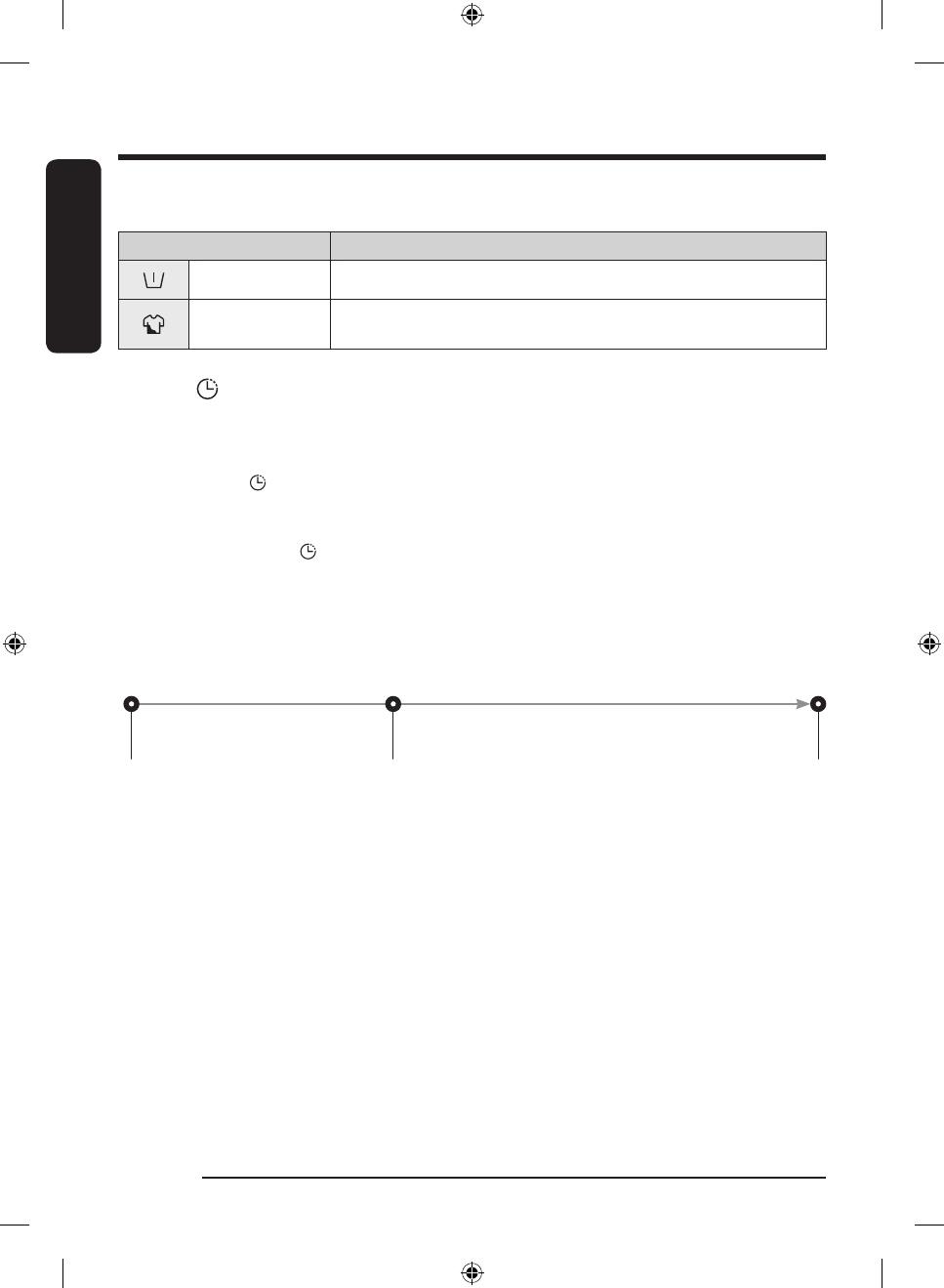
English
Operations
English40
Options
Option Description
Prewash • This will add a preliminary washing cycle before the main wash cycle.
Intensive
• For badly soiled laundry. The operation time for each cycle is longer
than normal.
Delay End
You can set the washing machine to finish your wash automatically at a later time, choosing a delay of
between 1 to 19 hours (in 1 hour increments). The hour displayed indicates the time the wash will finish.
1. Select a cycle. Then change the cycle settings if necessary.
2. Press Delay End repeatedly until a desired end time is set.
3. Press Start/Pause.
The corresponding indicator turns on with the clock running.
4. To cancel the Delay End , restart the washing machine by pressing Power.
Real-life case
You want to finish a two-hour cycle 3 hours later from now. For this, you add the Delay End option to
the current cycle with the 3-hour setting, and press
Start/Pause at 2:00 p.m. Then, what happens? The
washing machine starts operating at 3:00 p.m., and ends at 5:00 p.m. Provided below is the time line for
this example.
2:00 pm
Set Delay End to 3 hours
3:00 pm
Start
5:00 pm
End
Untitled-1 40 2021-02-03 10:43:22

English
English 41
Settings
Child Lock
To prevent accidents by children, Child Lock locks
all buttons except for Power.
• To set the Child Lock function, hold down
Temp. and Spin simultaneously for
3 seconds.
• To release the Child Lock function, hold down
Temp. and Spin simultaneously for 3
seconds.
NOTE
• In the Child Lock state, you must first release
the Child Lock if you want to add detergent or
laundry.
• Your setting will be kept even after restarting
the machine.
Sound On/Off
You can turn on or off the key. Your setting will
remain effective after you restart the machine.
• To mute the sound, hold down
Spin and
Options simultaneously for 3 seconds.
• To unmute the sound, hold down again for 3
seconds.
Untitled-1 41 2021-02-03 10:43:22

English
English42
Maintenance
Keep the washing machine clean to prevent deteriorated performance and to preserve its life cycle.
Drum clean
Perform this cycle regularly to clean the drum by removing bacteria from it. This cycle heats the water
between 60 °C and 70 °C, and it also removes accumulated dirt from the rubber door gasket.
1. Press Power to turn on the washing machine.
2. Turn the Cycle Selector to select DRUM CLEAN.
3. Press and hold Start/Pause.
NOTE
• The water temperature for DRUM CLEAN is set to 70 °C, which cannot be changed.
• It is recommended to run the DRUM CLEAN cycle once every 40 washes.
• To prevent limescale, add the proper amount of detergent according to your local water hardness or add
a water softener additive together with the detergent.
DRUM CLEAN reminder
Depending on the model, the
DRUM CLEAN reminder is either an icon or an LED.
For icons, the icon lights up on the control panel.
For LEDs, the LED lights up next to
DRUM CLEAN, or on the option area of the control panel.
• The
DRUM CLEAN reminder blinks on the control panel once every 40 washes. It is advisable to perform
DRUM CLEAN regularly.
• When you first see this reminder blinking, you can ignore the reminder for 6 consecutive washes. From
the 7
th
wash, the reminder no longer appears. However, it appears again on the second 40
th
wash.
• Even after the last process is terminated, the "0" message may remain.
• You can record the running count of the DRUM CLEAN cycle by pressing the Power button. This does
not stop or turn off the machine but marks your cycle count.
• Even if "0" does not disappear, the machine operates normally.
• It is recommended to run the cycle regularly for hygienic purposes.
Untitled-1 42 2021-02-03 10:43:22

English
English 43
Smart Check
To enable this function, you must first download the Samsung Smart Washer app at the Play Store or the
App Store, and install it on a mobile device featuring a camera function.
The Smart Check function has been optimised for Galaxy & iPhone series (applicable models only).
1. When the washing machine detects an issue to check, an information code appears on the display. To
enter Smart Check mode, press and hold Options and Delay End simultaneously for 3 seconds.
2. The washing machine starts the self-diagnosis procedure and displays an information code if a problem
is detected.
3. Run the Samsung Smart Washer app on your mobile device, and tap Smart Check.
4. Put the mobile device close to the washing machine’s display so that the smartphone camera and the
washing machine face each other. Then, the information code will be recognised automatically by the
app.
5. When the information code is recognised correctly, the app provides detailed information about the
problem with applicable solutions.
NOTE
• The function name, Smart Check, may differ depending on the language.
• If the washing machine reflects light on the display, the app may fail to recognise the information code.
• If the app fails to recognise the Smart Check code consecutively, enter the information code manually
onto the app screen.
Untitled-1 43 2021-02-03 10:43:22
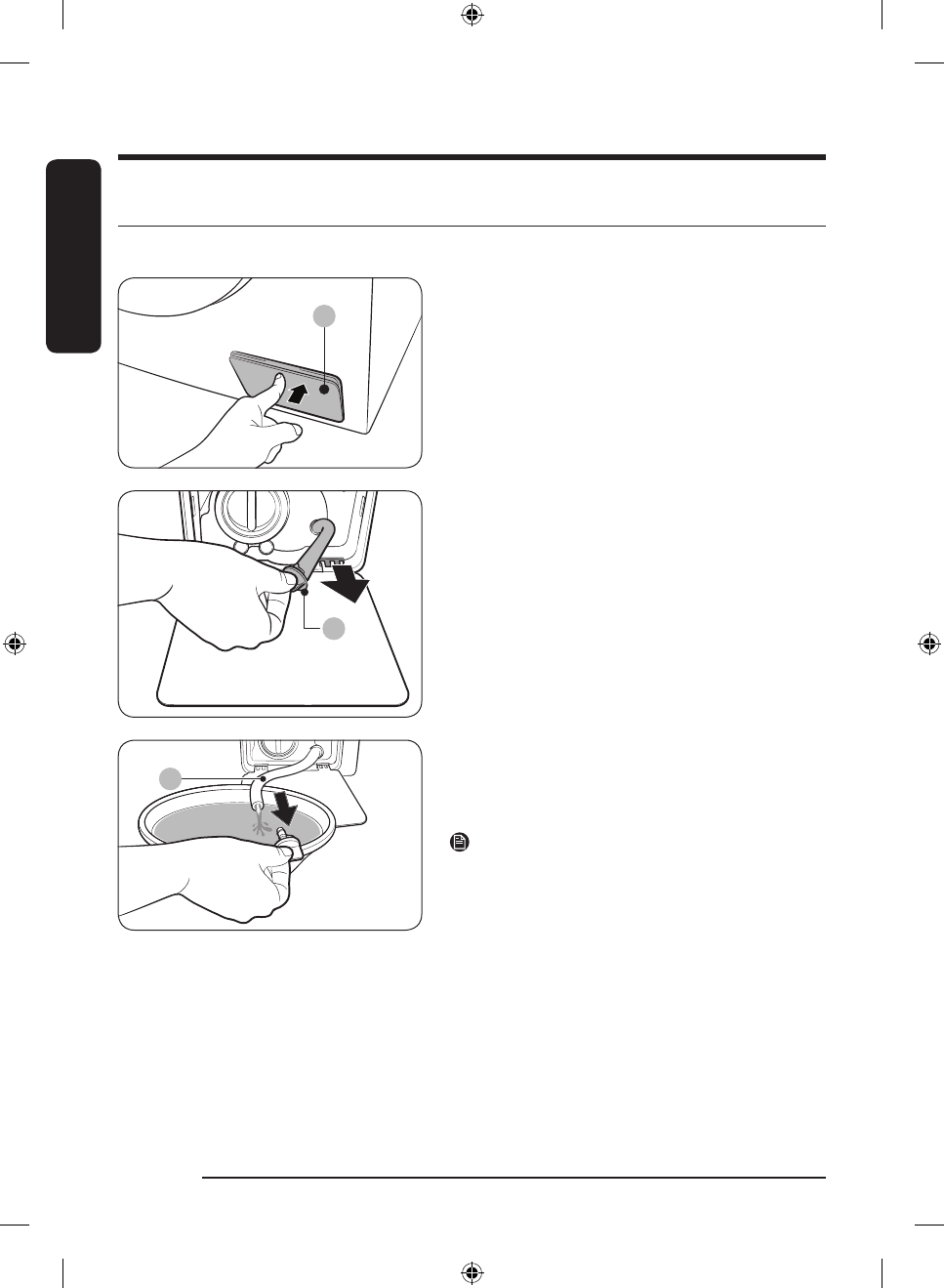
English
Maintenance
English44
Emergency drain
In case of a power failure, drain the water inside the drum before taking out the laundry.
A
1. Power off and unplug the washing machine from the
electrical outlet.
2. Gently press the top area of the filter cover (A) to
open.
B
3. Put an empty, spacious container around the
cover, and stretch the emergency drain tube to the
container while holding the tube cap (B).
C
4. Open the tube cap and let water in the emergency
drain tube (C) flow into the container.
5. When done, close the tube cap, and reinsert the tube.
Then, close the filter cover.
NOTE
Use a spacious container because the water in the drum
may be more than expected.
Untitled-1 44 2021-02-03 10:43:23
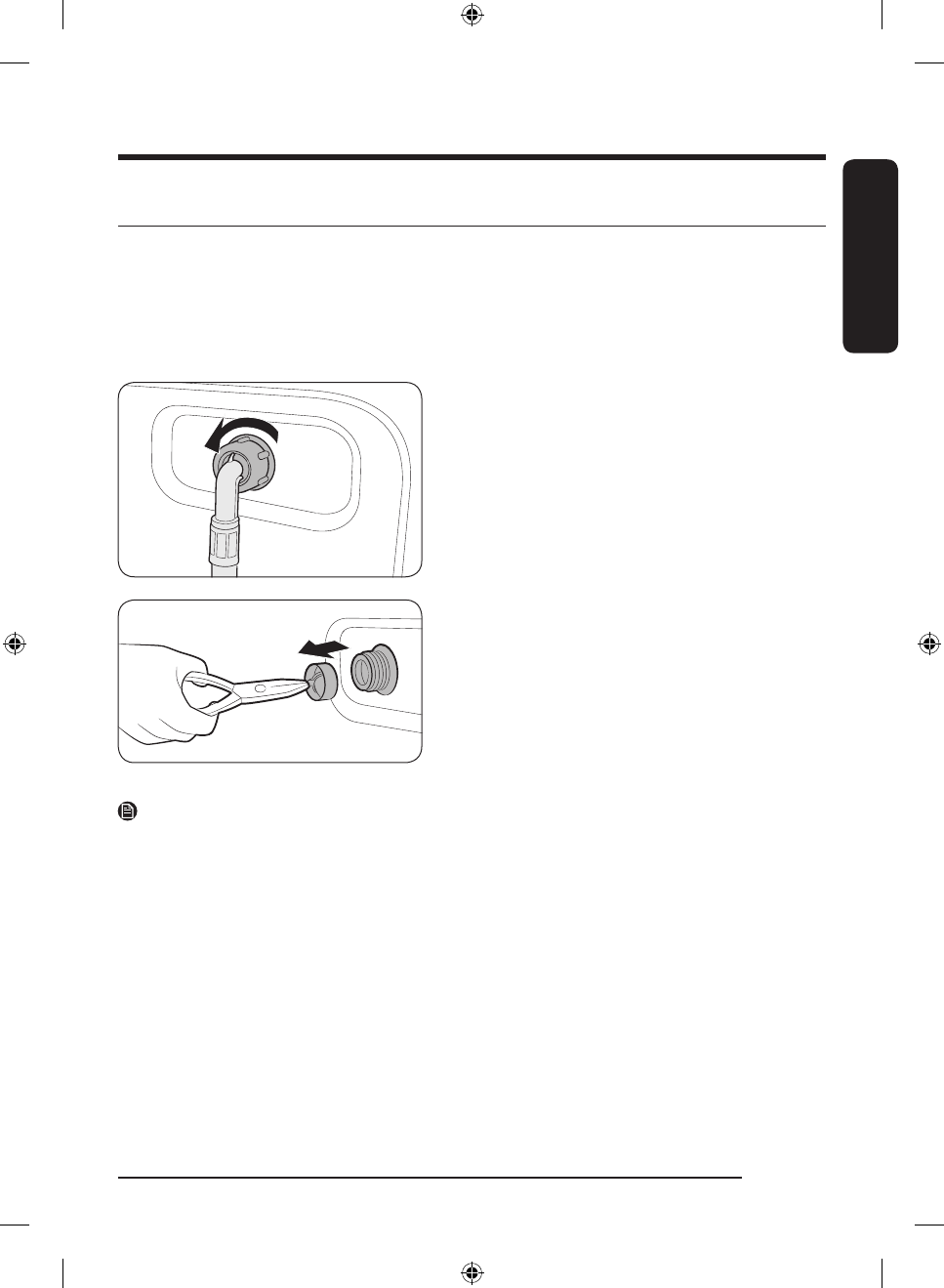
English
English 45
Cleaning
Surface of the washing machine
Use a soft cloth with a nonabrasive household detergent. Do not spray water onto the washing machine.
Mesh filter
Clean the mesh filter of the water hose once or twice a year.
1. Turn off the washing machine, and unplug the power
cord.
2. Close the water tap.
3. Loosen and disconnect the water hose from the back
of the washing machine. Cover the hose with a cloth
to prevent water from gushing out.
4. Use pliers to pull out the mesh filter from the inlet
valve.
5. Submerge the mesh filter deeply in water so that the
threaded connector is also submerged.
6. Dry the mesh filter completely in the shade.
7. Reinsert the mesh filter into the inlet valve, and
reconnect the water hose to the inlet valve.
8. Open the water tap.
NOTE
If the mesh filter is clogged, an information code of “4C” appears on the screen.
Untitled-1 45 2021-02-03 10:43:23
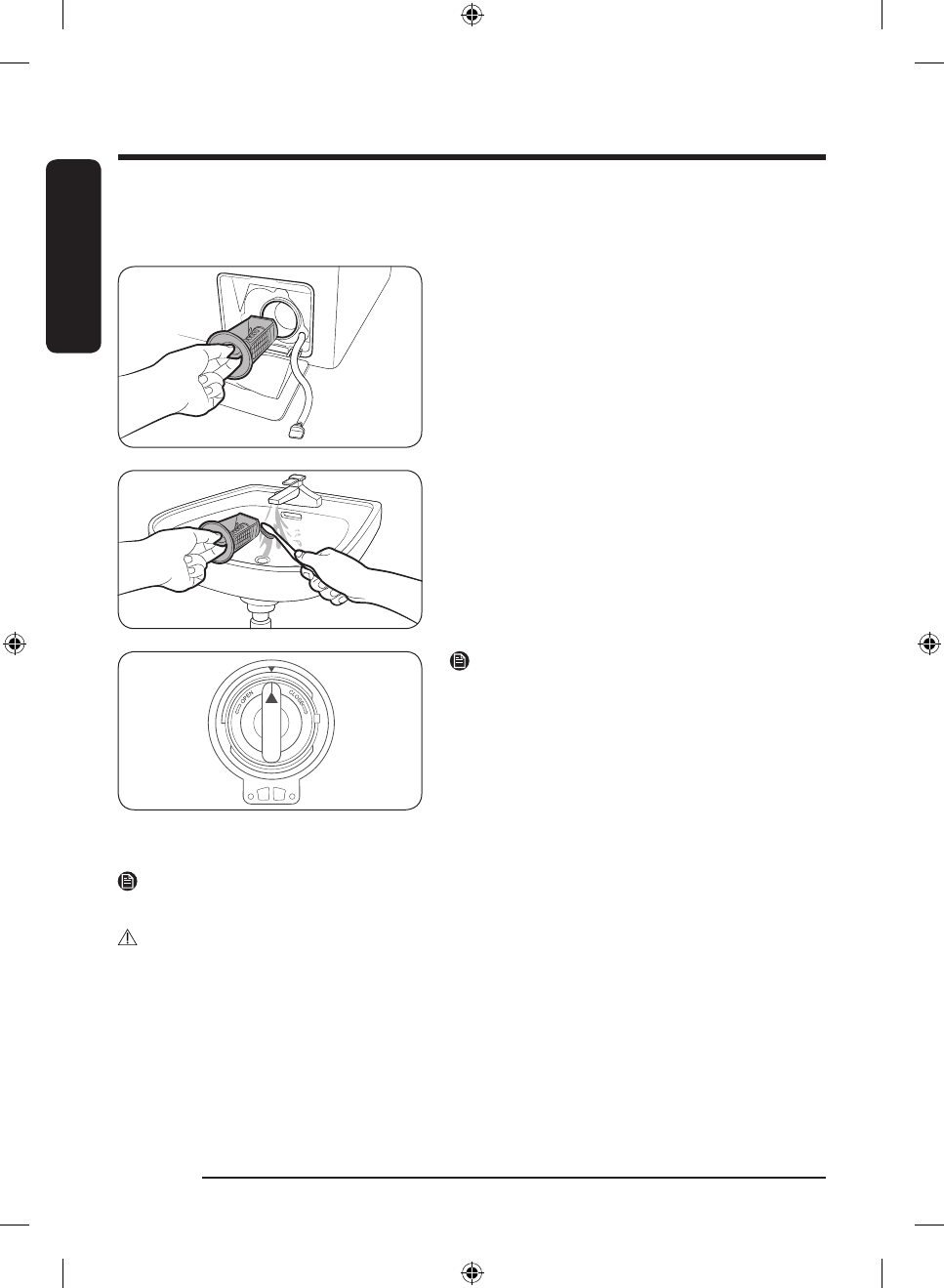
English
Maintenance
English46
Debris filter
Clean the debris filter bi-monthly to prevent clogging. A clogged debris filter may reduce the bubble effect.
1. Turn off the washing machine, and unplug the power
cord.
2. Drain the remaining water inside the drum. See the
“Emergency drain” section.
3. Gently press the top area of the filter cover to open.
4. Turn the debris filter knob to the left, and drain off
the remaining water.
5. Clean the debris filter using soft brushes. Make
sure the drain pump propeller inside the filter is
unclogged.
6. Reinsert the debris filter, and turn the filter knob to
the right.
NOTE
• Some debris filters feature a safety knob that is
designed to prevent accidents by children. To open
the safety knob of the debris filter, push in and turn
it anticlockwise. The spring mechanism of the safety
knob helps open the filter.
• To close the safety knob of the debris filter, turn it
clockwise. The spring makes a rattling sound, which
is normal.
NOTE
If the debris filter is clogged, an information code of “5C” appears on the screen.
CAUTION
• Make sure the filter knob is closed properly after cleaning the filter. Otherwise, this may cause a leak.
• Make sure the filter is inserted properly after cleaning it. Otherwise, this may cause an operational
failure or a leak.
Untitled-1 46 2021-02-03 10:43:23
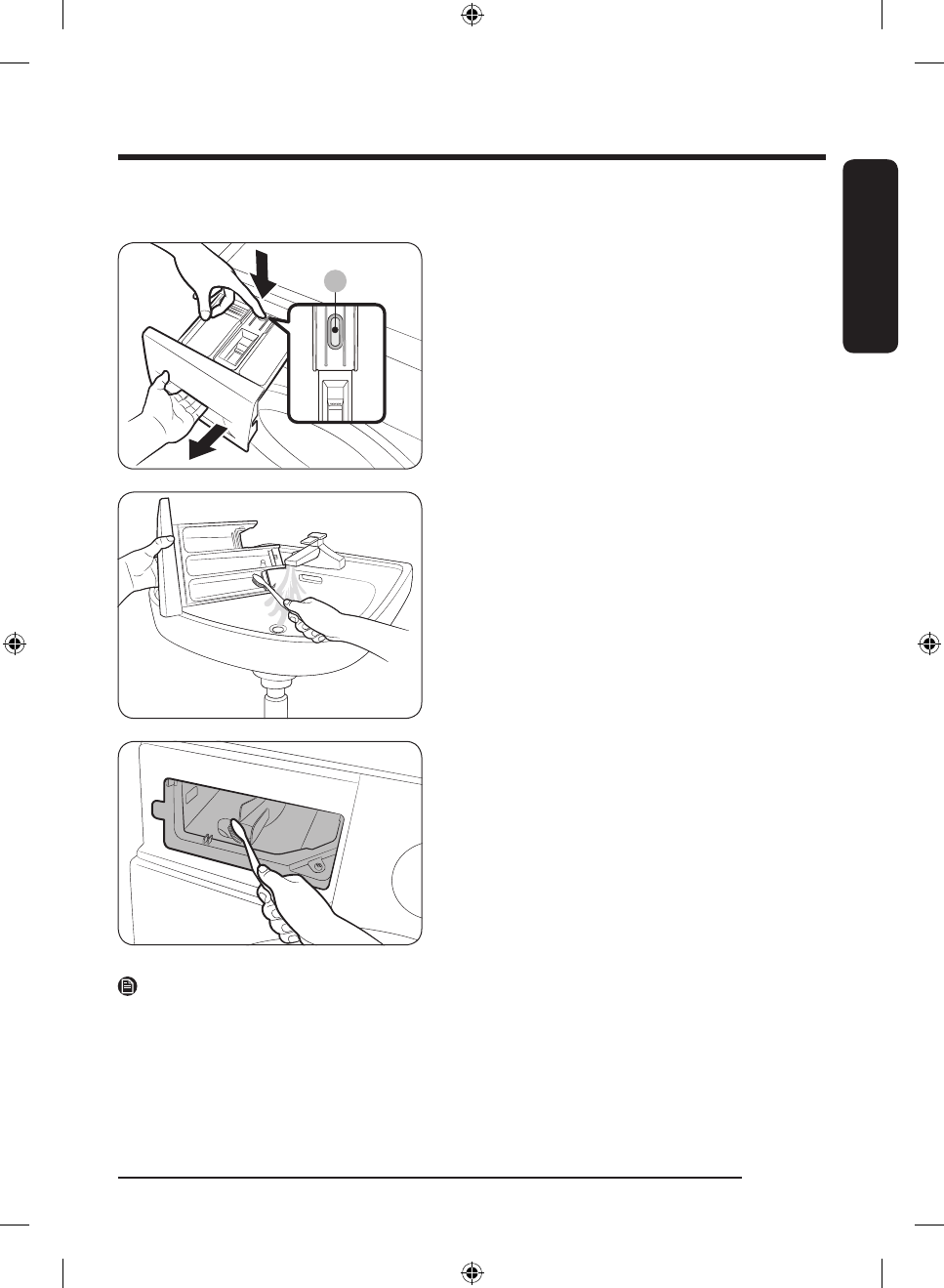
English
English 47
Detergent drawer
A
1. While holding down the release lever (A) on the inner
of the drawer, slide open the drawer.
2. Remove the release lever and the liquid detergent
guide from the drawer.
3. Clean the drawer components in flowing water using
a soft brush.
4. Clean the drawer recess using a bottle brush to
remove detergent residues and limescale on the
drawer recess.
5. Reinsert the release lever and the liquid detergent
guide to the drawer.
6. Slide the drawer inward to close it.
NOTE
To remove remaining detergent, perform the RINSE+SPIN cycle with the drum being empty.
Untitled-1 47 2021-02-03 10:43:24

English
Maintenance
English48
Recovery from freezing
The washing machine may freeze when it drops below 0 °C.
1. Turn off the washing machine, and unplug the power cord.
2. Pour warm water over the water tap to loosen the water hose.
3. Disconnect the water hose, and soak it in warm water.
4. Pour warm water into the drum and leave it for about 10 minutes.
5. Reconnect the water hose to the water tap.
NOTE
If the washing machine still doesn’t operate normally, repeat the above steps until it operates normally.
Care against an extended time of disuse
Avoid leaving the washing machine unused for an extended time. If this is the case, drain the washing
machine and unplug the power cord.
1. Turn the Cycle Selector to select a RINSE+SPIN.
2. Empty the drum, and press Start/Pause.
3. When the cycle is complete, close the water tap and disconnect the water hose.
4. Turn off the washing machine, and unplug the power cord.
5. Open the door to let air circulate through the drum.
Untitled-1 48 2021-02-03 10:43:24
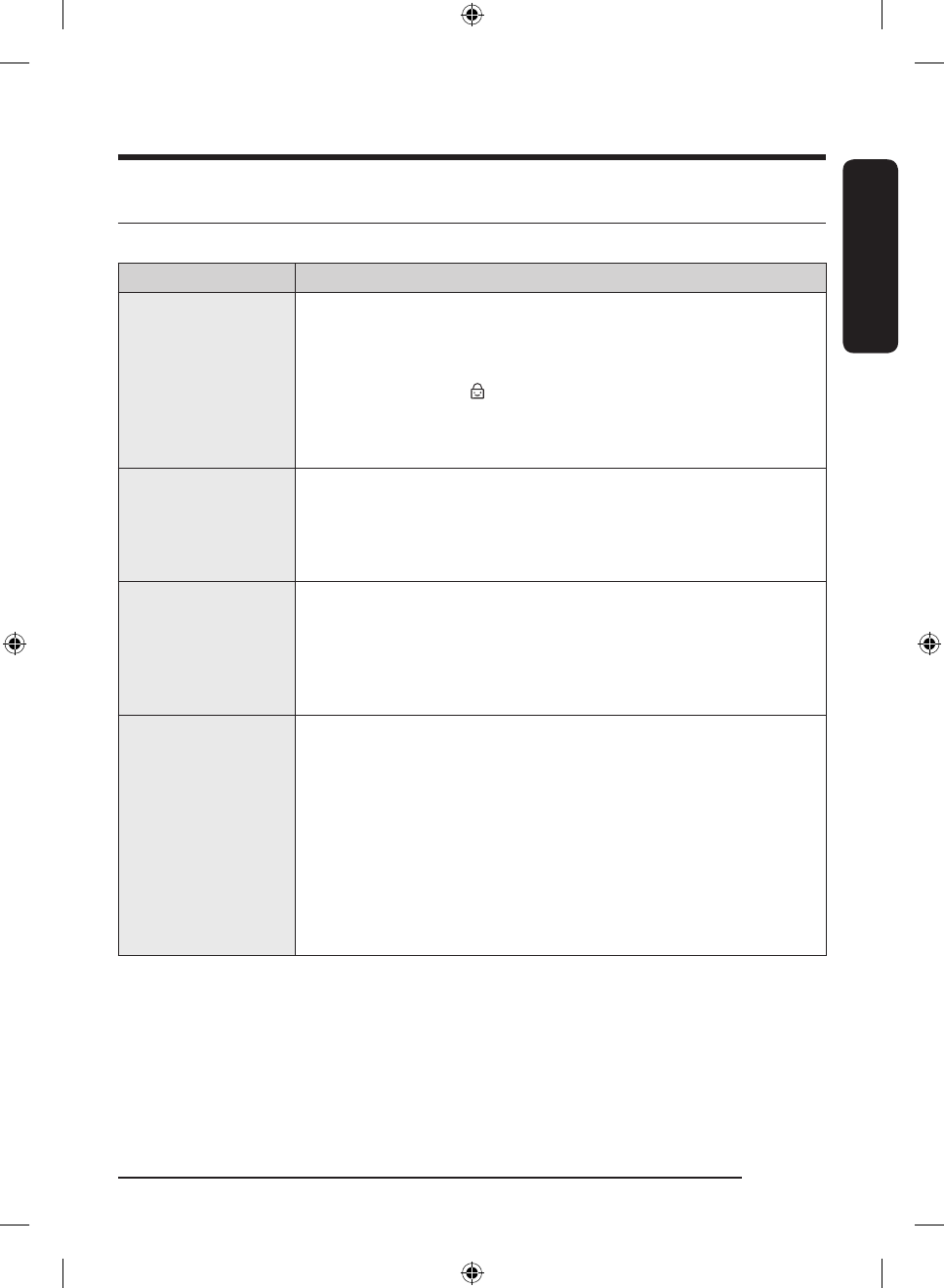
English
English 49
Troubleshooting
Checkpoints
If you encounter a problem with the washing machine, first check the table below and try the suggestions.
Problem Action
Does not start.
• Make sure the washing machine is plugged in.
• Make sure the door is properly closed.
• Make sure the water taps are open.
• Make sure to press or tap Start/Pause to start the washing machine.
• Make sure Child Lock is not activated.
• Before the washing machine starts to fill, it will make a series of clicking
noises to check the door lock and does a quick drain.
• Check the fuse or reset the circuit breaker.
Water supply is
insufficient, or no water
is supplied.
• Fully open the water tap.
• Make sure the door is properly closed.
• Make sure the water supply hose is not frozen.
• Make sure the water supply hose is not kinked or clogged.
• Make sure there is sufficient water pressure.
After a cycle, detergent
remains in the
detergent drawer.
• Make sure the washing machine is running with sufficient water pressure.
• Make sure the detergent is added to the centre of the detergent drawer.
• Make sure the rinse cap is inserted properly.
• If using granular detergent, make sure the detergent selector is in the
upper position.
• Remove the rinse cap and clean the detergent drawer.
Excessive vibrations or
makes noise.
• Make sure the washing machine is installed on a level, solid floor that is
not slippery. If the floor is not level, use the levelling feet to adjust the
height of the washing machine.
• Make sure the shipping bolts are removed.
• Make sure the washing machine is not contacting any other object.
• Make sure the laundry load is balanced.
• The motor can cause noise during normal operation.
• Overalls or metal-decorated clothes can cause noise while being washed.
This is normal.
• Metal objects such as coins can cause noise. After washing, remove these
objects from the drum or filter case.
Untitled-1 49 2021-02-03 10:43:24
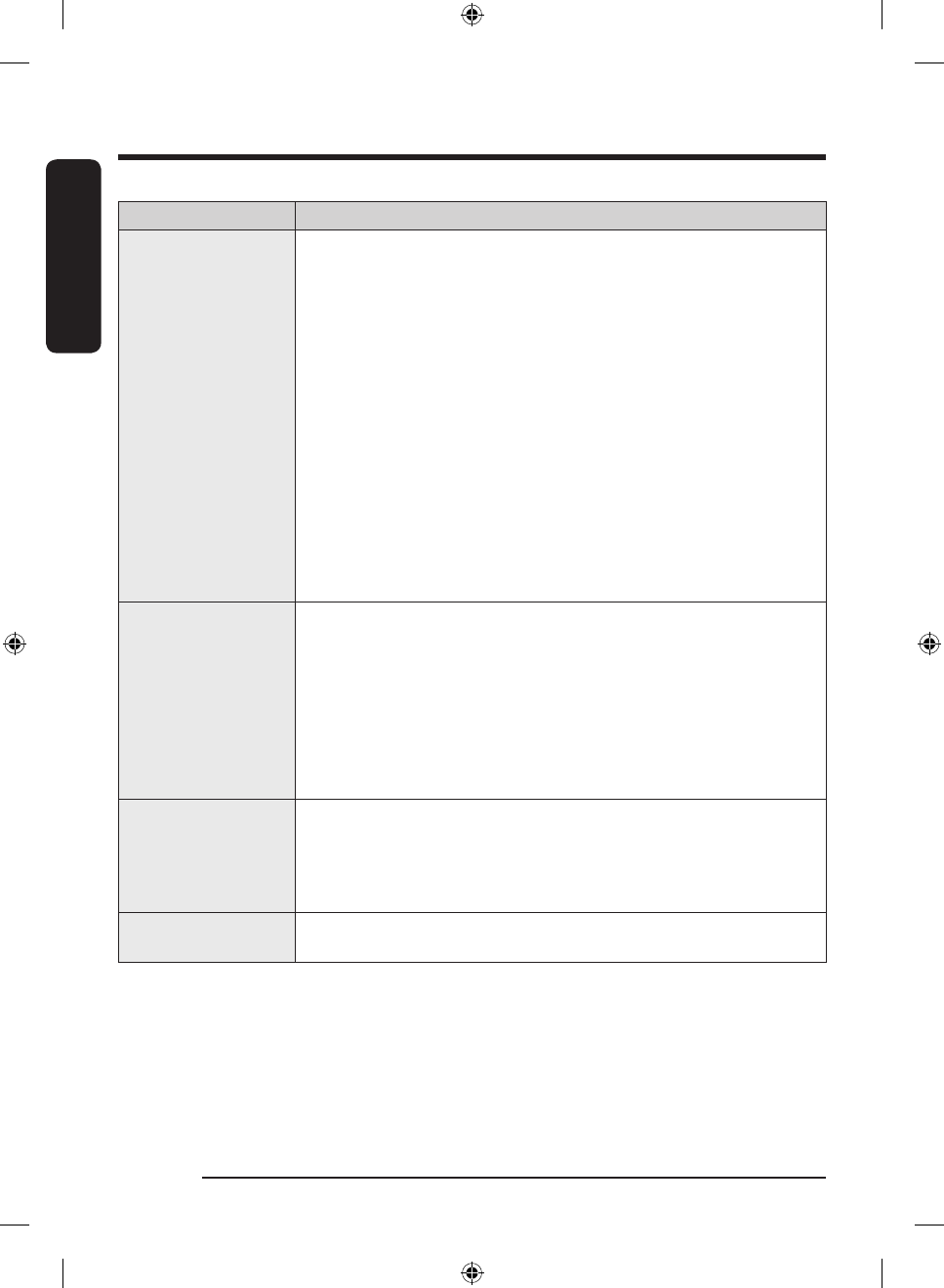
English
Troubleshooting
English50
Problem Action
Does not drain and/ or
spin.
• Make sure the drain hose is straightened all the way to the drain system. If
you encounter a drain restriction, call for service.
• Make sure the debris filter is not clogged.
• Close the door and press or tap Start/Pause. For your safety, the washing
machine will not tumble or spin unless the door is closed.
• Make sure the drain hose is not frozen or clogged.
• Make sure the drain hose is connected to a drain system that is not
clogged.
• If the washing machine is not supplied with sufficient power, the washing
machine temporarily will not drain or spin. As soon as the washing
machine regains sufficient power, it will operate normally.
Spinning does not work.
• Make sure laundry is spread out evenly.
• Make sure the washing machine is on a flat, stable surface.
• Redistribute the load. If only one item of clothing needs washing, such as a
bathrobe or pair of jeans, the final spin result might be unsatisfactory, and
an “Ub” check message will be shown in the display.
The door does not open.
• Press or tap
Start/Pause to stop the washing machine.
• It may take a few moments for the door lock mechanism to disengage.
• The door will not open until 3 minutes after the washing machine has
stopped or the power turned off.
• Make sure all the water in the drum is drained.
• The door may not open if water remains in the drum. Drain the drum and
open the door manually.
• Make sure the door lock light is off. The door lock light turns off after the
washing machine has drained.
Excessive suds.
• Make sure you use the recommended types of detergent as appropriate.
• Use high efficiency (HE) detergent to prevent oversudsing.
• Reduce the detergent amount for soft water, small loads, or lightly soiled
loads.
• Non-HE detergent is not recommended.
Cannot apply additional
detergent.
• Make sure the remaining amount of detergent and fabric softener is not
over the limit.
Untitled-1 50 2021-02-03 10:43:24

English
English 51
Problem Action
Stops.
• Plug the power cord into a live electrical outlet.
• Check the fuse or reset the circuit breaker.
• Close the door and press the Start/Pause button to start the washing
machine. For your safety, the washing machine will not tumble or spin
unless the door is closed.
• Before the washing machine starts to fill, it will make a series of clicking
noises to check the door lock and does a quick drain.
• There may be a pause or soak period in the cycle. Wait briefly and the
washing machine may start.
• Make sure the mesh filter of the water supply hose at the water taps are
not clogged. Periodically clean the mesh filter.
• If the washing machine is not supplied with sufficient power, the washing
machine temporarily will not drain or spin. As soon as the washing
machine regains sufficient power, it will operate normally.
Fills with the wrong
water temperature.
• Fully open both taps.
• Make sure the temperature selection is correct.
• Make sure the hoses are connected to the correct taps. Flush water lines.
• Make sure the water heater is set to supply a minimum 120 °F (49 °C) hot
water at the tap. Also, check the water heater capacity and recovery rate.
• Disconnect the hoses and clean the mesh filter. The mesh filter may be
clogged.
• While the washing machine fills, the water temperature may change
as the automatic temperature control feature checks incoming water
temperature. This is normal.
• While the washing machine fills, you may notice just hot and/or just cold
water going through the dispenser when cold or warm temperatures are
selected. This is a normal function of the automatic temperature control
feature as the washing machine determines the water temperature.
Load is wet at the end
of a cycle.
• Use the High or Extra High spin speed.
• Use high efficiency (HE) detergent to reduce oversudsing.
• Load is too small. Small loads (one or two items) may become unbalanced
and not spin completely.
• Make sure the drain hose is not kinked or clogged.
Leaks water.
• Make sure the door is properly closed.
• Make sure all hose connections are tight.
• Make sure the end of the drain hose is correctly inserted and secured to
the drain system.
• Avoid overloading.
• Use high efficiency (HE) detergent to prevent oversudsing.
Untitled-1 51 2021-02-03 10:43:24

English
Troubleshooting
English52
Problem Action
Has odours.
• Excessive suds collect in recesses and can cause foul odours.
• Run cleansing cycles to sanitize periodically.
• Clean the door seal (diaphragm).
• Dry the washing machine interior after a cycle has finished.
No bubbles are seen
(Bubbleshot models
only).
• Overloading may screen bubbles.
• Severely contaminated laundry may not generate bubbles.
• If a problem persists, contact a service center. The number of the service center is on the label attached
to the product.
• Samsung is not liable for any damage to the product, any injury, or any other product safety issue caused
by a repair which does not follow the instructions in these Repair Guides. Any damage to the product
caused by an attempted repair (by anyone other than a Samsung certified service provider) will also not
be covered by the warranty.
Untitled-1 52 2021-02-03 10:43:24
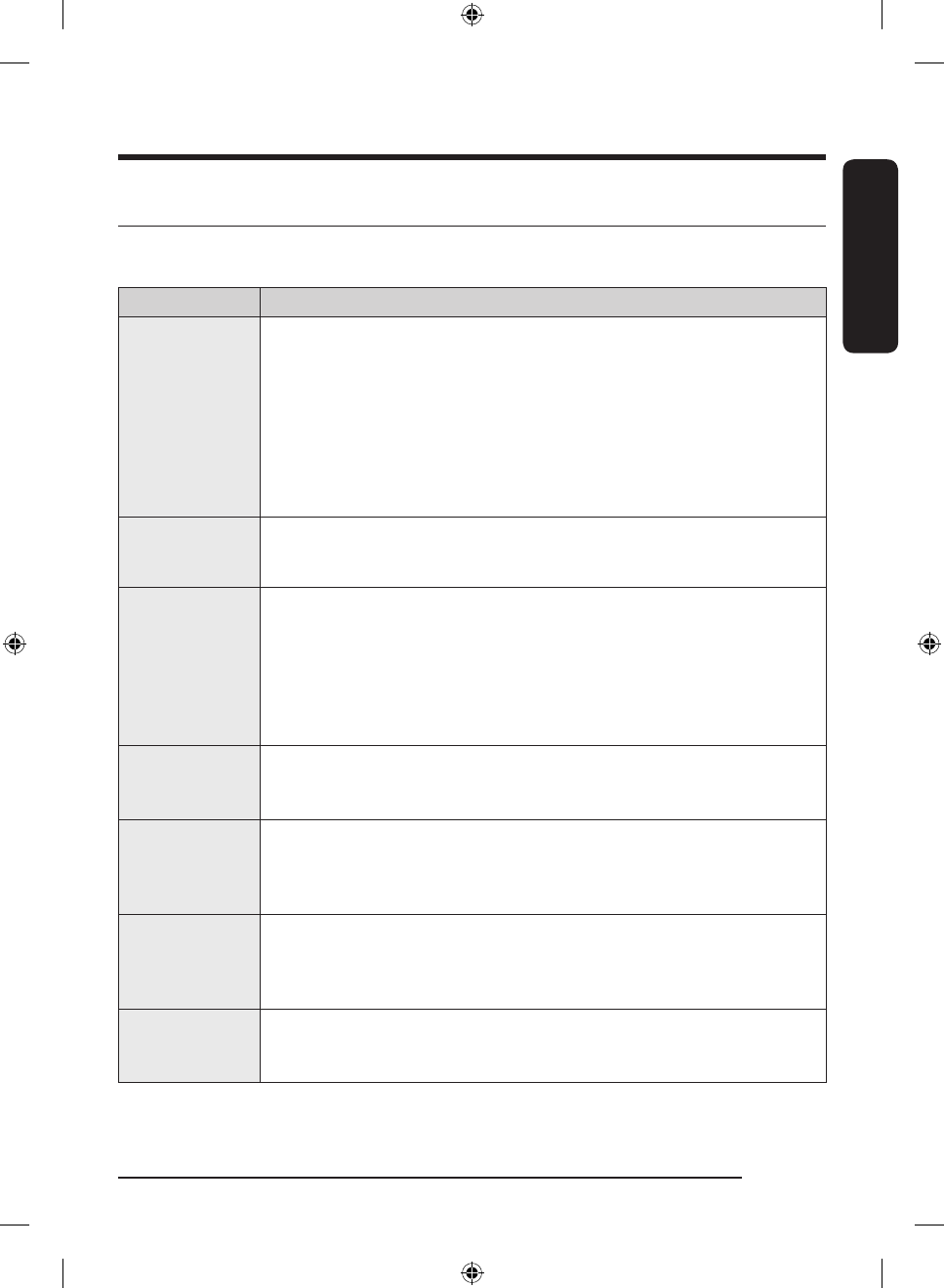
English
English 53
Information codes
If the washing machine fails to operate, you may see an information code on the screen. Check the table
below and try the suggestions.
Code Action
4C
Water is not supplied.
• Make sure the water taps are open.
• Make sure the water hoses are not clogged.
• Make sure the water taps are not frozen.
• Make sure the washing machine is operating with sufficient water pressure.
• Make sure that the cold water tap and the hot water tap are properly connected.
• Clean the mesh filter as it may be clogged.
• When the "4C" message appears, the machine drains water for 3 minutes. In the
meantime, the power button will be disabled.
4C2
• Make sure the cold water supply hose is firmly connected to the cold water tap.
If it is connected to the hot water tap, the laundry may be deformed with some
cycles.
5C
Water is not draining.
• Make sure the drain hose is not frozen or clogged.
• Make sure the drain hose is positioned correctly, depending on the connection
type.
• Clean the debris filter as it may be clogged.
• Make sure the drain hose is straightened all the way to the drain system.
• If the information code remains, contact a customer service centre.
dC
Operating the washing machine with the door open.
• Make sure the door is properly closed.
• Make sure laundry is not caught in the door.
OC
Water is overflowed.
• Restart after spinning.
• If the information code remains on the display, contact a local Samsung service
centre.
LC, LC1
Check the drain hose.
• Make sure the end of the drain hose is not placed on the floor.
• Make sure the drain hose is not clogged.
• If the information code remains, contact a customer service centre.
3C
Check the motor for operation.
• Try restarting the cycle.
• If the information code remains, contact a customer service centre.
Untitled-1 53 2021-02-03 10:43:24
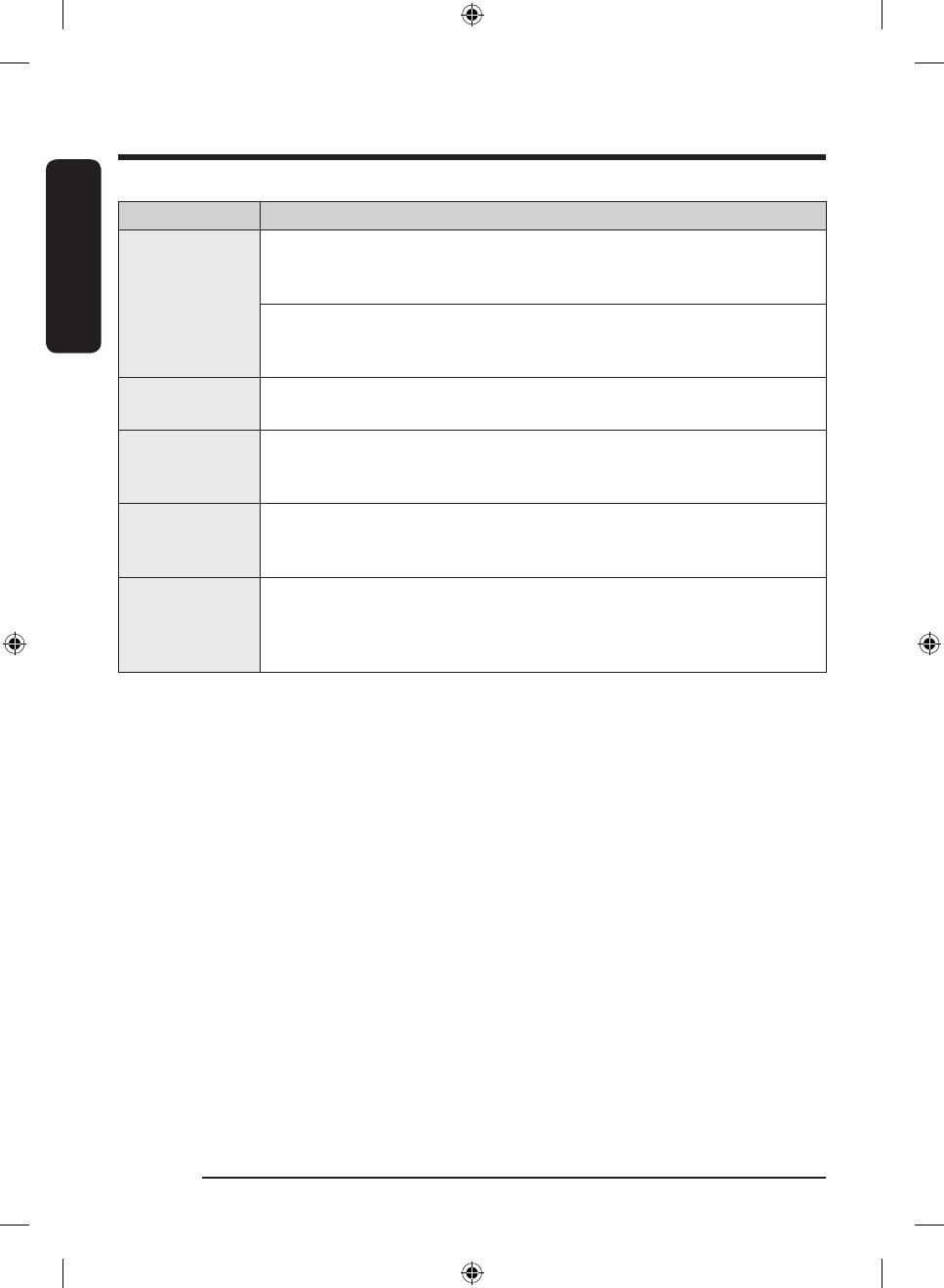
English
Troubleshooting
English54
Code Action
UC
The electronic control needs to be checked.
• Check if power is supplied properly.
• If the information code remains, contact a customer service centre.
Low voltage detected.
• Check if the power cord is plugged in.
• If the information code remains, contact a customer service centre.
HC
High temperature heating check.
• If the information code remains, contact a customer service centre.
1C
The Water Level sensor is not working properly.
• Try power off and restarting the cycle.
• If the information code remains, contact a customer service centre.
AC
Check communications between main and sub PBAs.
• Try power off and restarting the cycle.
• If the information code remains, contact a customer service centre.
0
The machine does not turn off automatically after the last spinning process, and
the "0" message remains.
• The machine operates normally without running the
DRUM CLEAN cycle.
However, it is recommended to run the cycle for hygienic purposes.
If any information code keeps appearing on the screen, contact a local Samsung service centre.
Untitled-1 54 2021-02-03 10:43:25

English
English 55
Specifications
Fabric care chart
The following symbols provide garment care
direction. The Clothing care labels include
symbols for drying, bleaching, drying and ironing,
or dry cleaning when necessary. The use of
symbols ensures consistency among garment
manufacturers of domestic and imported items.
Follow care label directions to maximize garment
life and reduce laundering problems.
Washing
95 °C boil wash.
60 °C coloured wash.
60 °C coloured wash. (“Easy care”
coloured wash)
40 °C coloured wash.
40 °C mild wash.
40 °C very mild wash.
30 °C fine wash.
30 °C mild fine wash.
30 °C very mild fine wash.
Hand wash.
Do not wash.
NOTE
The numbers in the wash tub specify the
maximum washing temperatures in degrees
celsius Celsius which must not be exceeded.
Bleaching
Any bleach allowed.
Only oxygen bleach allowed.
Do not bleach.
Drying
Tumble drying / Drying at a
temperature of 80 °C with a normal
drying process.
Tumble drying / Drying at a
temperature of 60 °C with a mild
drying process.
Do not tumble dry
Line drying.
Drip line drying.
Flat drying.
Drip flat drying.
Line drying in the shade.
Drip line drying in the shade.
Flat drying in the shade.
Drip flat drying in the shade.
NOTE
• The dots indicate the drying level of the dryer.
• The lines indicate the type and place of the
drying.
Untitled-1 55 2021-02-03 10:43:27
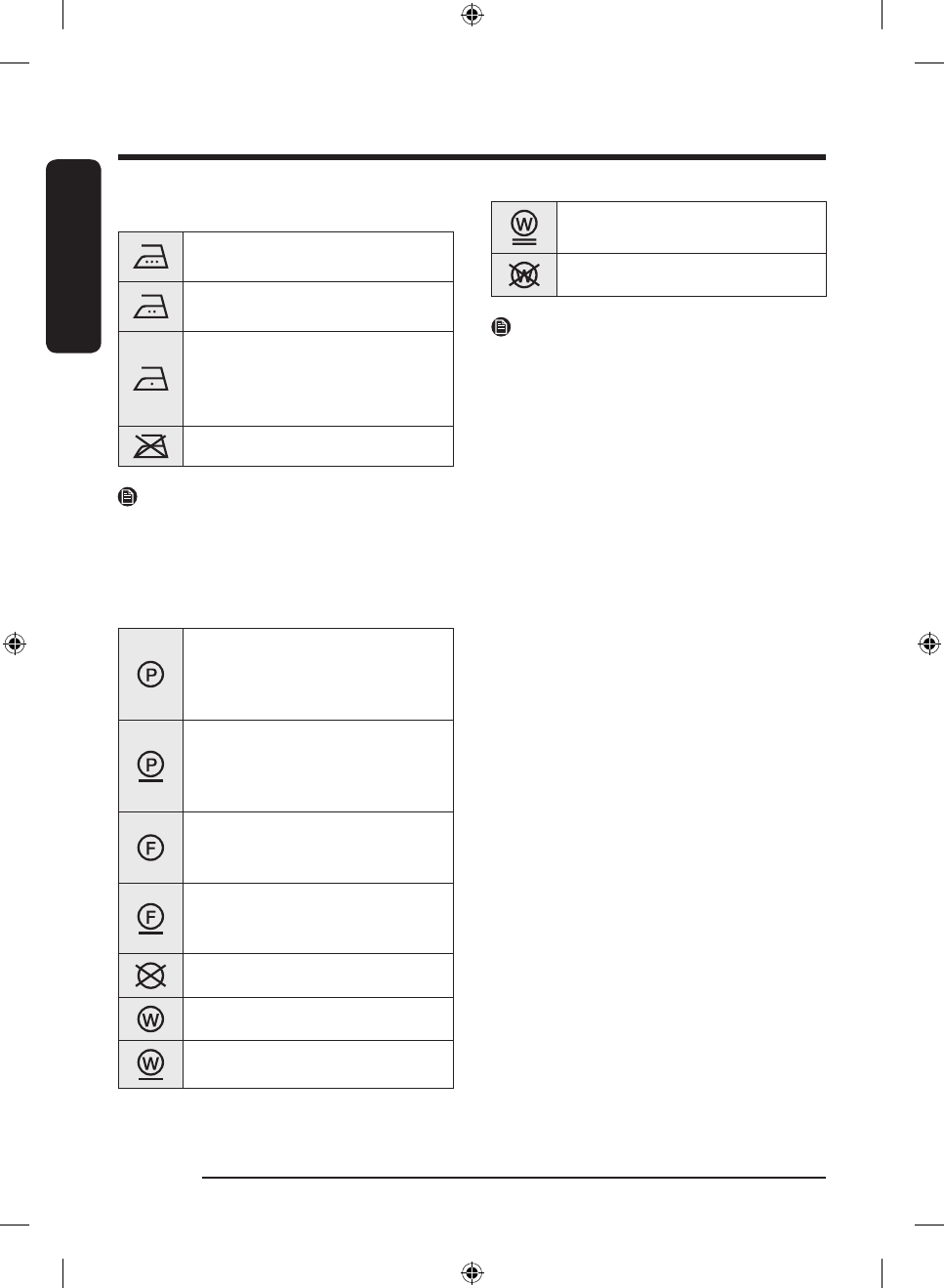
English
Specifications
English56
Ironing
Iron at maximum sole plate
temperature of 200 °C.
Iron at maximum sole plate
temperature of 150 °C.
Iron at maximum sole plate
temperature of 110 °C.
Caution when using steam irons (work
without steam).
Do not iron.
NOTE
The dots indicate the temperature ranges for
ironing (regulator, steam, travel irons and ironing
machines).
Professional care
Professional dry-cleaning in
perchloroethylene and/or
hydrocarbons (heavy benzines) with
normal process.
Professional dry-cleaning in
perchloroethylene and/or
hydrocarbons (heavy benzines) with
gentle process.
Professional dry-cleaning in
hydrocarbons (heavy benzines) with
normal process.
Professional dry-cleaning in
hydrocarbons (heavy benzines) with
gentle process.
Do not dry-clean.
Professional wet-cleaning.
Mild professional wet-cleaning.
Very mild professional wet-cleaning.
Do not wet-clean.
NOTE
• The letters in a circle indicate the solvents (P,
F) used in dry cleaning or wet cleaning (W).
• Generally, the line under the symbol indicates
a milder treatment (e.g. gentle cycle for easy-
care items). The double line indicates care
levels with particularly gentle treatment.
Untitled-1 56 2021-02-03 10:43:29

English
English 57
Protecting the environment
• This appliance is manufactured from recyclable materials. If you decide to dispose of it, please observe
local waste disposal regulations. Cut off the power cord so that the appliance cannot be connected
to a power source. Remove the lid so that animals and small children cannot get trapped inside the
appliance.
• Do not exceed the detergent quantities recommended in the detergent manufacturers’ instructions.
• Use stain removal products and bleaches before the wash cycle only when necessary.
• Save water and electricity by only washing full loads (the exact amount depends upon the program
used).
Spare parts guarantee
We guarantee that the following spare parts will be available to professional repairers and end-users for a
minimum period of 10 years after placing the last unit of the model on the market.
• Door, door hinges and seals, other seals, door locking assembly, and plastic peripherals such as
detergent dispensers.
• Listed parts can be purchased at below website.
- http://www.samsung.com/support
Untitled-1 57 2021-02-03 10:43:29
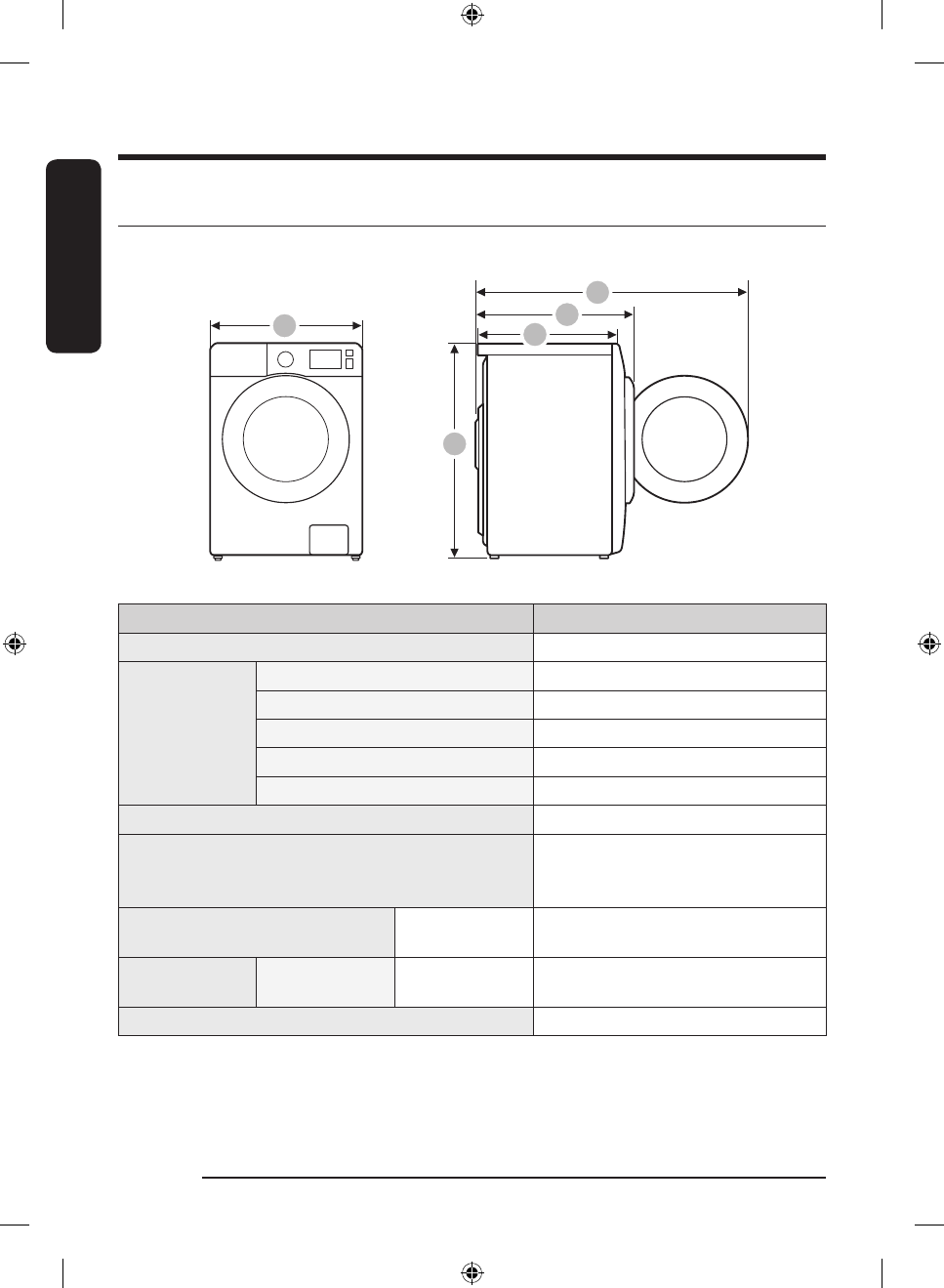
English
Specifications
English58
Specification sheet
“*” Asterisk(s) means variant model and can be varied (0-9) or (A-Z).
A
B
C
D
E
Type Front loading washing machine
Model name WW9*TA*4***
Dimensions
A (Width) 600 mm
B (Height) 850 mm
C (Depth) 550 mm
D 635 mm
E 1072 mm
Water pressure 50-1000 kPa
Net weight
67.0 kg (WW**T*8****, WW**T*5****,
WW**T*3****)
65.0 kg (WW**T*0****)
Maximum load capacity
Washing and
spinning
9.0 kg
Power
consumption
Washing and
heating
AC 220-240 V /
50 Hz
1900-2300 W
Spin revolutions 1400 RPM
Untitled-1 58 2021-02-03 10:43:29
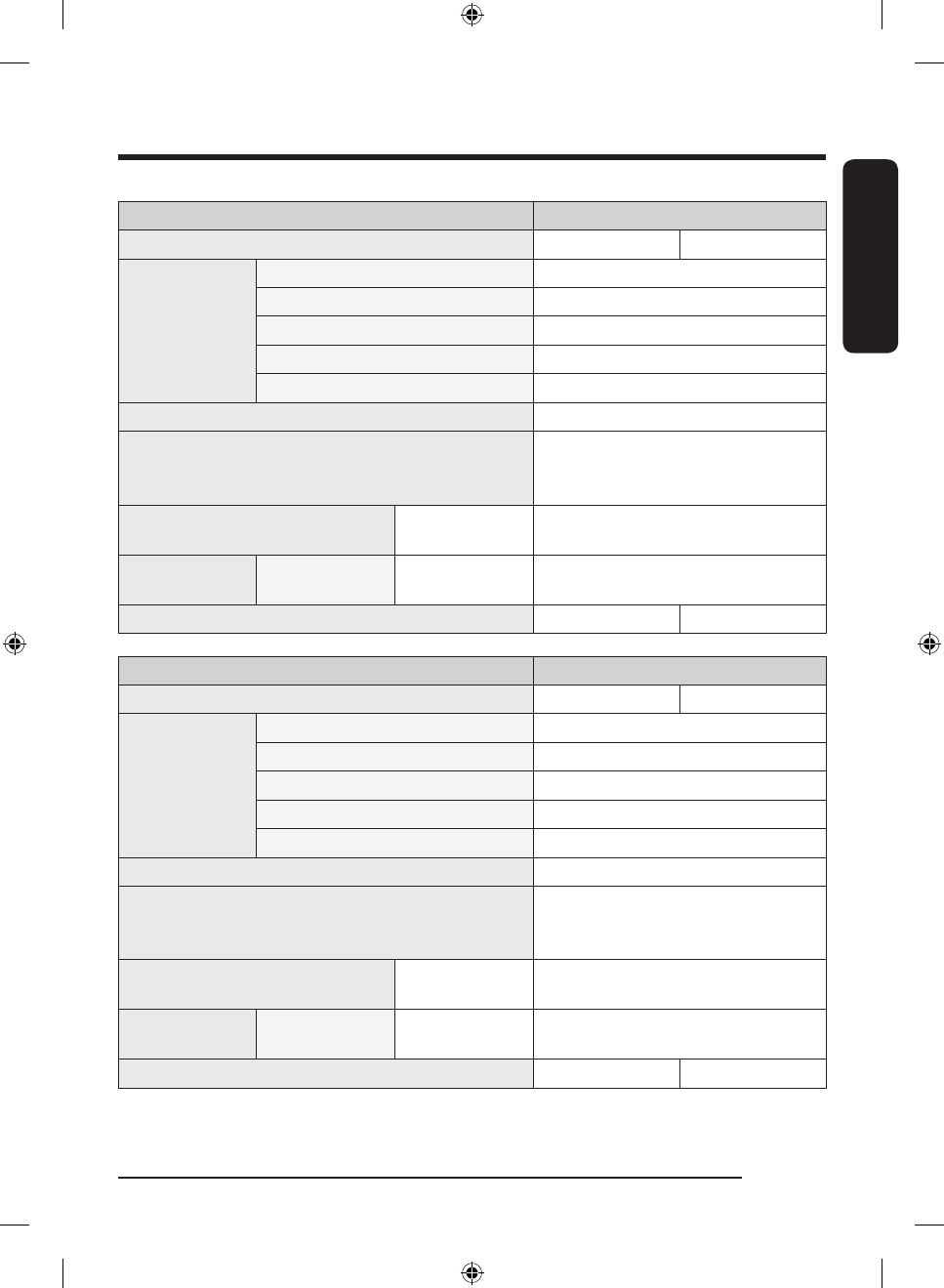
English
English 59
Type Front loading washing machine
Model name WW8*TA*4*** WW8*TA*2***
Dimensions
A (Width) 600 mm
B (Height) 850 mm
C (Depth) 550 mm
D 635 mm
E 1072 mm
Water pressure 50-1000 kPa
Net weight
67.0 kg (WW**T*8****, WW**T*5****,
WW**T*3****)
65.0 kg (WW**T*0****)
Maximum load capacity
Washing and
spinning
8.0 kg
Power
consumption
Washing and
heating
AC 220-240 V /
50 Hz
1900-2300 W
Spin revolutions 1400 RPM 1200 RPM
Type Front loading washing machine
Model name WW7*TA*4*** WW7*TA*2***
Dimensions
A (Width) 600 mm
B (Height) 850 mm
C (Depth) 550 mm
D 635 mm
E 1072 mm
Water pressure 50-1000 kPa
Net weight
67.0 kg (WW**T*8****, WW**T*5****,
WW**T*3****)
65.0 kg (WW**T*0****)
Maximum load capacity
Washing and
spinning
7.0 kg
Power
consumption
Washing and
heating
AC 220-240 V /
50 Hz
1900-2300 W
Spin revolutions 1400 RPM 1200 RPM
Untitled-1 59 2021-02-03 10:43:29

English
Specifications
English60
NOTE
The design and specifications are subject to change without notice for quality improvement purposes.
EPREL information
To access the EPREL registration of the model :
1. Go to https://eprel.ec.europa.eu
2. Get the model identifier from the energy label of the product and type it in the search box
3. Energy Labelling information of the model is shown
* You can directly access the product information via https://eprel.ec.europa.eu/qr/#####(registration no.)
The registration no. can be found on the rating label on your product.
Indicative information (According to EU 2019/2023)
Model Cycles Capacity (kg)
Program Time
(HH:MM)
Energy
Consumption
(kWh/Cycle)
Water
Consumption
(L/cycle)
Maximum
Temperature
(°C)
Remaining
Moisture
Content (%)
Spinning
Speed (RPM)
WW9*TA*4***
ECO 40-60
9.0 3:48 0.809 71.0 31 49.5 1400
4.5 2:54 0.509 46.0 27 51.0 1400
2.5 2:36 0.216 36.0 21 53.0 1400
COTTON 20 °C 9.0 3:19 0.357 117.0 20 53.0 1400
COTTON 60 °C 9.0 2:25 1.504 134.0 55 53.0 1400
COTTON 60 °C +
Bubble Soak
9.0 2:55 2.099 134.0 60 53.0 1400
SYNTHETICS
40 °C
4.0 2:25 0.680 68.0 40 32.0 1200
15' QUICK WASH
Cold
2.0 0:15 0.015 43.0 15 105.0 800
WW9*TA*2***
ECO 40-60
9.0 3:48 0.809 71.0 31 49.5 1200
4.5 2:54 0.509 46.0 27 51.0 1200
2.5 2:36 0.216 36.0 21 58.5 1200
COTTON 20 °C 9.0 3:19 0.357 117.0 20 56.0 1200
COTTON 60 °C 9.0 2:25 1.504 134.0 55 56.0 1200
COTTON 60 °C +
Bubble Soak
9.0 2:55 2.099 134.0 60 56.0 1200
SYNTHETICS
40 °C
4.0 2:25 0.680 68.0 40 32.0 1200
15' QUICK WASH
Cold
2.0 0:15 0.015 43.0 15 105.0 800
Untitled-1 60 2021-02-03 10:43:30
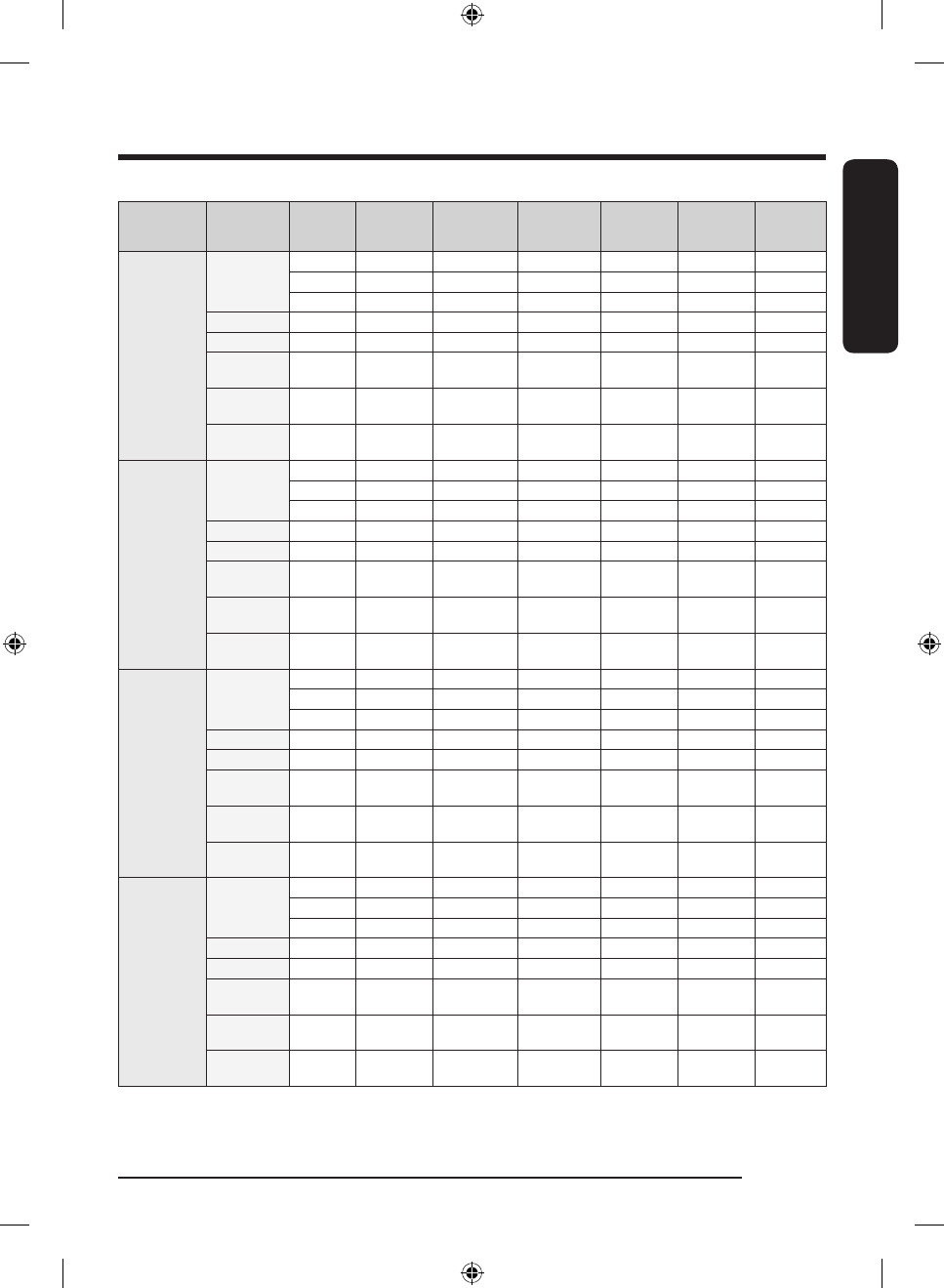
English
English 61
Model Cycles Capacity (kg)
Program Time
(HH:MM)
Energy
Consumption
(kWh/Cycle)
Water
Consumption
(L/cycle)
Maximum
Temperature
(°C)
Remaining
Moisture
Content (%)
Spinning
Speed (RPM)
WW8*TA*4***
ECO 40-60
8.0 3:38 0.805 65.0 33 50.0 1400
4.0 2:48 0.525 45.0 30 51.5 1400
2.0 2:31 0.278 31.0 23 53.0 1400
COTTON 20 °C 8.0 3:19 0.339 104.0 20 53.0 1400
COTTON 60 °C 8.0 2:25 1.659 127.0 55 53.0 1400
COTTON 60 °C +
Bubble Soak
8.0 2:55 2.192 127.0 60 53.0 1400
SYNTHETICS
40 °C
4.0 2:25 0.680 68.0 40 32.0 1200
15' QUICK WASH
Cold
2.0 0:15 0.015 43.0 15 105.0 800
WW8*TA*2***
ECO 40-60
8.0 3:38 0.805 65.0 33 50.0 1200
4.0 2:48 0.525 45.0 30 51.5 1200
2.0 2:31 0.278 31.0 23 58.5 1200
COTTON 20 °C 8.0 3:19 0.339 104.0 20 56.0 1200
COTTON 60 °C 8.0 2:25 1.659 127.0 55 56.0 1200
COTTON 60 °C +
Bubble Soak
8.0 2:55 2.192 127.0 60 56.0 1200
SYNTHETICS
40 °C
4.0 2:25 0.680 68.0 40 32.0 1200
15' QUICK WASH
Cold
2.0 0:15 0.015 43.0 15 105.0 800
WW7*TA*4***
ECO 40-60
7. 0 3:28 0.722 59.5 31 50.5 1400
3.5 2:42 0.478 41.2 27 52.5 1400
2.0 2:31 0.267 30.0 24 53.0 1400
COTTON 20 °C 7. 0 3:19 0.336 120.0 20 53.0 1400
COTTON 60 °C 7. 0 2:25 1.587 117.0 55 53.0 1400
COTTON 60 °C +
Bubble Soak
7. 0 2:55 2.011 117.0 60 53.0 1400
SYNTHETICS
40 °C
4.0 2:25 0.680 68.0 40 32.0 1200
15' QUICK WASH
Cold
2.0 0:15 0.015 43.0 15 105.0 800
WW7*TA*2***
ECO 40-60
7. 0 3:28 0.722 59.5 31 50.5 1200
3.5 2:42 0.478 41.2 27 52.5 1200
2.0 2:31 0.267 30.0 24 58.5 1200
COTTON 20 °C 7. 0 3:19 0.336 120.0 20 56.0 1200
COTTON 60 °C 7. 0 2:25 1.587 117.0 55 56.0 1200
COTTON 60 °C +
Bubble Soak
7. 0 2:55 2.011 117.0 60 56.0 1200
SYNTHETICS
40 °C
4.0 2:25 0.680 68.0 40 32.0 1200
15' QUICK WASH
Cold
2.0 0:15 0.015 43.0 15 105.0 800
Untitled-1 61 2021-02-03 10:43:30
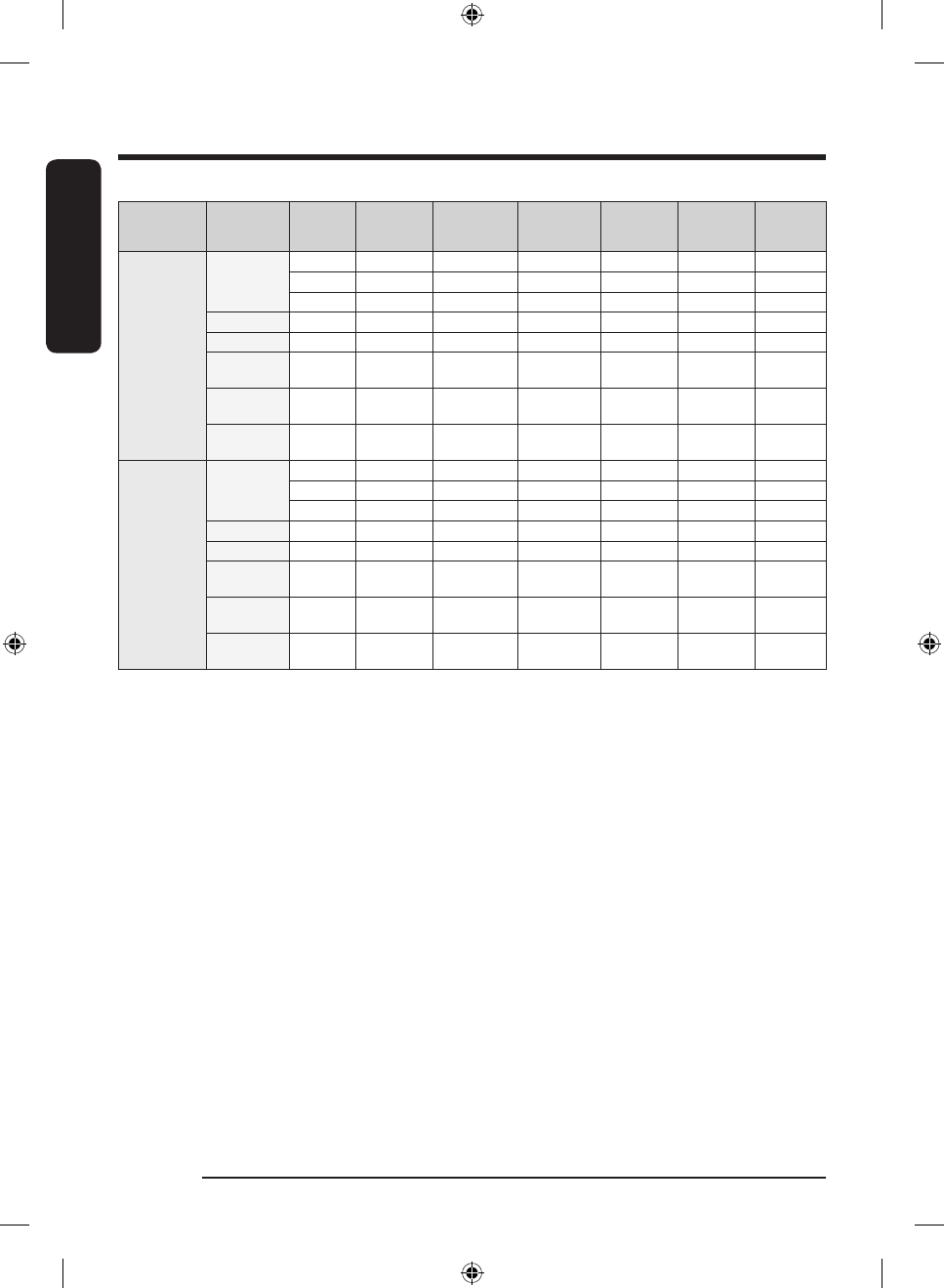
English
Specifications
English62
Model Cycles Capacity (kg)
Program Time
(HH:MM)
Energy
Consumption
(kWh/Cycle)
Water
Consumption
(L/cycle)
Maximum
Temperature
(°C)
Remaining
Moisture
Content (%)
Spinning
Speed (RPM)
WW8*TA*2***(*)
ECO 40-60
8.0 3:38 0.805 65.0 33 50.0 1200
4.0 2:48 0.525 45.0 30 51.5 1200
2.0 2:31 0.278 31.0 23 58.5 1200
COTTON 20 °C 8.0 3:19 0.339 104.0 20 56.0 1200
COTTON 60 °C 8.0 2:25 1.659 127.0 55 56.0 1200
COTTON 60 °C +
Bubble Soak
8.0 2:55 2.192 127.0 60 56.0 1200
SYNTHETICS
40 °C
4.0 2:25 0.680 68.0 40 32.0 1200
15' QUICK WASH
Cold
2.0 0:15 0.015 43.0 15 105.0 800
WW7*TA*2***(*)
ECO 40-60
7. 0 3:28 0.742 62.0 31 50.5 1200
3.5 2:42 0.468 36.0 27 52.5 1200
2.0 2:31 0.251 31.0 24 58.5 1200
COTTON 20 °C 7. 0 3:19 0.336 120.0 20 56.0 1200
COTTON 60 °C 7. 0 2:25 1.587 117.0 55 56.0 1200
COTTON 60 °C +
Bubble Soak
7. 0 2:55 2.011 117.0 60 56.0 1200
SYNTHETICS
40 °C
4.0 2:25 0.680 68.0 40 32.0 1200
15' QUICK WASH
Cold
2.0 0:15 0.015 43.0 15 105.0 800
The values given for programmes other than the ECO 40-60 programme and the wash and dry cycle are
indicative only.
Untitled-1 62 2021-02-03 10:43:30

Memo
Untitled-1 63 2021-02-03 10:43:30

QUESTIONS OR COMMENTS?
COUNTRY CALL OR VISIT US ONLINE AT
UK 0333 000 0333 www.samsung.com/uk/support
IRELAND (EIRE) 0818 717100 www.samsung.com/ie/support
DC68-04206A-01
Untitled-1 64 2021-02-03 10:43:31
